

Examples of economic problems
The fundamental economic problem is the issue of scarcity but unlimited wants. Scarcity implies there is only a limited quantity of resources, e.g. finite fossil fuels. Because of scarcity, there is a constant opportunity cost – if you use resources to consume one good, you cannot consume another. Therefore, an underlying feature of economics is concerned with dealing how to allocate resources in society to make the most efficient and fair use of resources. The main issues are:
- What to produce?
- How to produce?
- For whom to produce?
Examples of economic problems include
- How to deal with external costs/pollution , e.g. pollution from production.
- How to redistribute income to reduce poverty , without causing loss of economic incentives.
- How to provide public goods (e.g. street-lighting) which are usually not provided in a free market.
- How should we measure economic welfare? Is it wrong to focus on ouptut and income? (as economics has in the past) – New measures of economic welfare try to include broader range of factors, such as environment, education, health care.
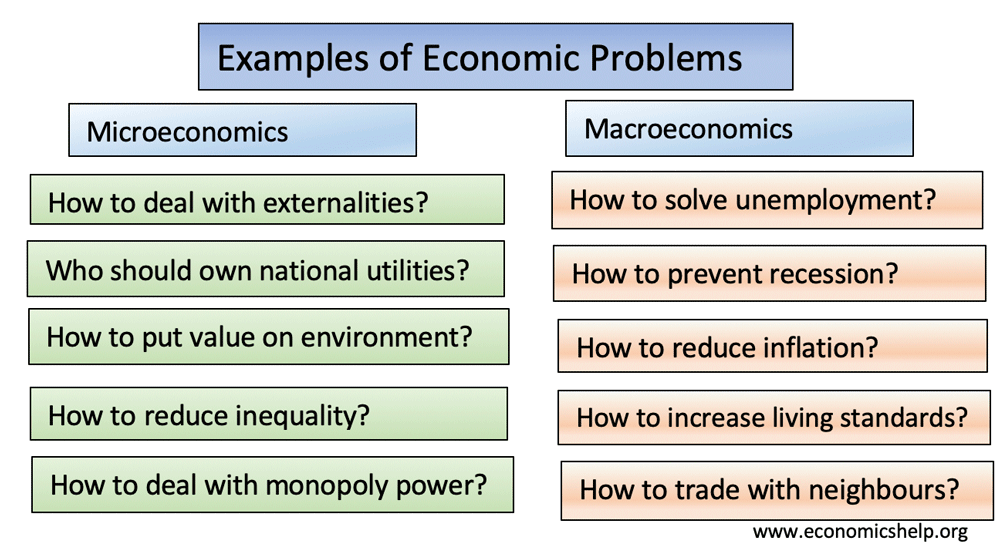
Video summary
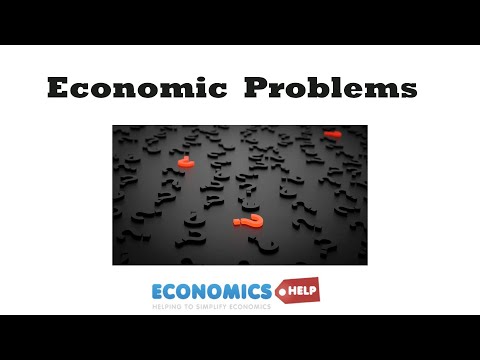
Micro economic problems
1. The problem of externalities

The economic problem of pollution
One of the most frequent problems is that economic decisions can have external effects on other people not involved in the transaction. For example, if you produce power from coal, the pollution affects people all over the world (acid rain, global warming). This is a particular problem because we cannot rely on the free market to provide the most efficient outcome. If we create negative externalities , we don’t take them into account when deciding how much to consume. This is why we can get overconsumption of driving a car into a city centre at peak hour. If everyone maximises their utility, it doesn’t lead to the most efficient outcome – but gridlock and wasted resources.
Externalities, usually need some kind of government intervention. For example, taxes on negative externalities (e.g. sugar tax) or subsidies on positive externalities (e.g. free public education) even banning cars in city centres.
But, even the solution to market failure (e.g. taxes), creates its own potential problems, such as how much to tax? will there be tax evasion? The administration costs of collecting tax.
Environmental issues
Economics is traditionally concerned with utility maximisation – allowing individuals to aim at increasing their economic welfare. However, this can ignore long-term considerations of environmental sustainability. If we have over-consumption in this century, it could cause serious problems for future generations – e.g. global warming, loss of non-renewable resources. The difficulty is that the price mechanism doesn’t take into account these future costs, and policies to reduce consumption may prove politically unpopular.
– How to deal with potential future environmental costs?
Monopoly was an economic problem that Adam Smith was concerned about in his influential book of economics “A Wealth of Nations.” For various reasons firms can gain monopoly power – and therefore the ability to set high prices to consumers. Given a lack of alternatives, monopolies can make high profits at the expense of consumers, causing inequality within society. Monopoly power can also be seen through monopsony employers who pay lower wages to their workers.
How to deal with the problem of monopoly? – A government may seek to encourage competition, e.g. rail franchising, or price regulation to prevent excessive prices.
Inequality/poverty
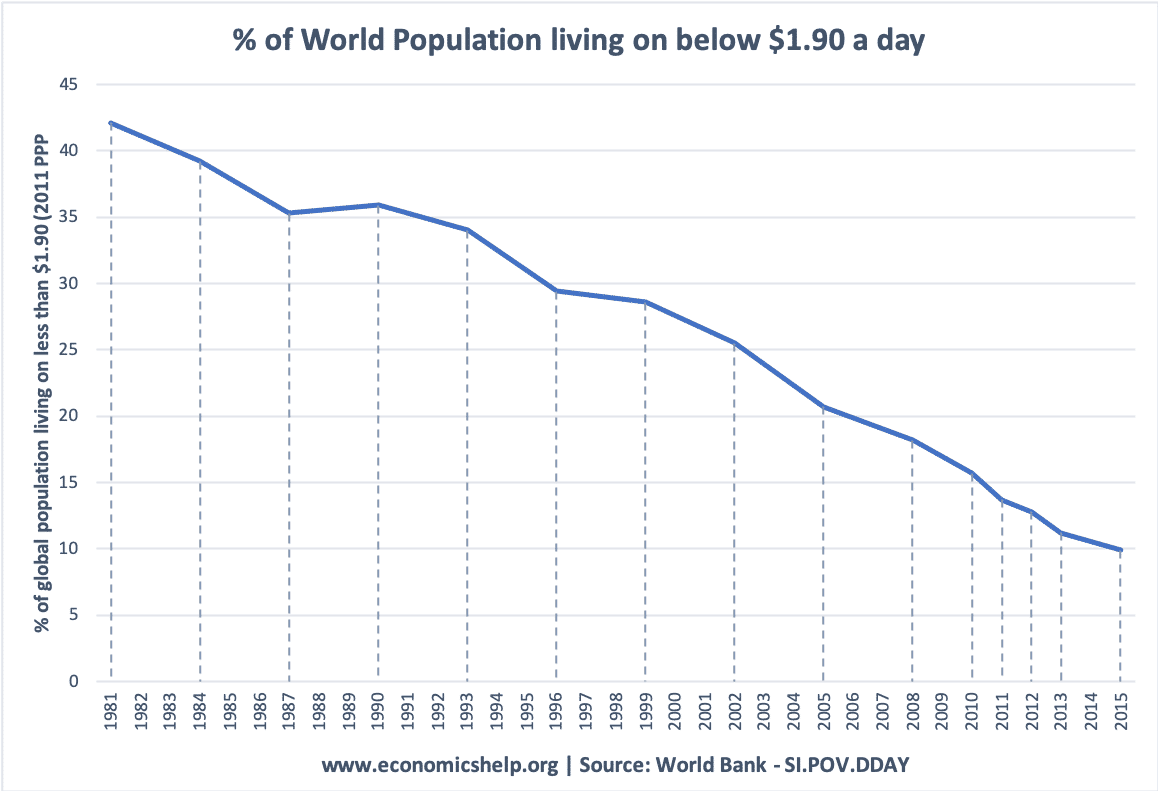
This shows that 10% of the world population still live on below $1.90 a day – though the figure has reduced in past three decades.
Inequality is considered a problem because of normative opinions such as – it is an unfair distribution of resources. Also, you could argue there is a diminishing marginal utility of wealth . If all wealth is owned by a small percentage of the population, this reduces net welfare. Redistributing the money to the very poor would enable a greater net utility to society.
Five of the world’s largest companies Apple, Microsoft, Alphabet, Cisco and Oracle, have a total of $504bn cash savings (2015) This is money unused, whilst people around the world have insufficient food.
Inequality is a problem. However, it is also a problem to know how much we should seek to reduce poverty. Many will agree on the necessity of reducing absolute poverty – but how far should we take it? Should we aim for perfect equality (Communism) or should we aim for equality of opportunity?
Another issue with reducing poverty is that measures to reduce poverty may cause unintended consequences – e.g. higher income tax on high earners may create disincentives to work. Giving benefits to the low paid may reduce incentives to work.
Volatile prices
Some agricultural markets can have volatile prices. A glut in supply can be bad news because the fall in price can lead to lower revenue for farmers. It could even cause some to go out of business because of a bad year. These volatile markets can cause swings in economic fortunes.
Irrational behaviour
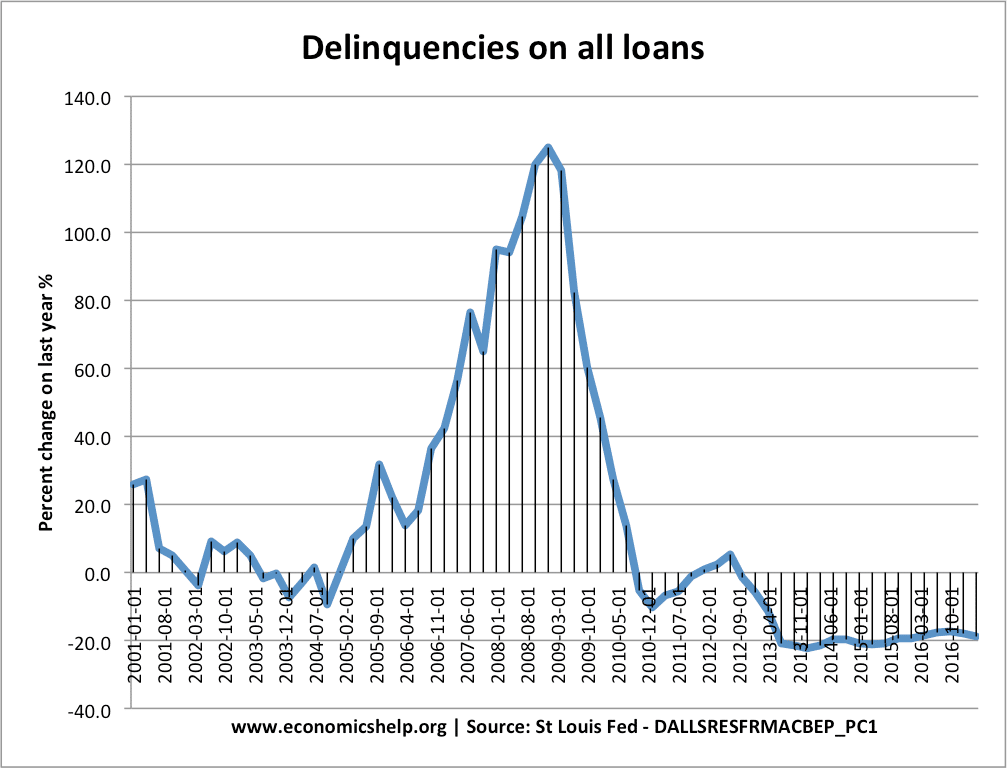
In some asset markets, we have seen volatile prices exacerbated by irrational exuberance . Consumers have often been caught up in a market frenzy – hoping that rising prices will make them richer – and expecting prices to keep rising. We can see this in issues such as tulip mania , the South Sea Bubble, railway mania, and the recent property bubbles.
Macroeconomic problems
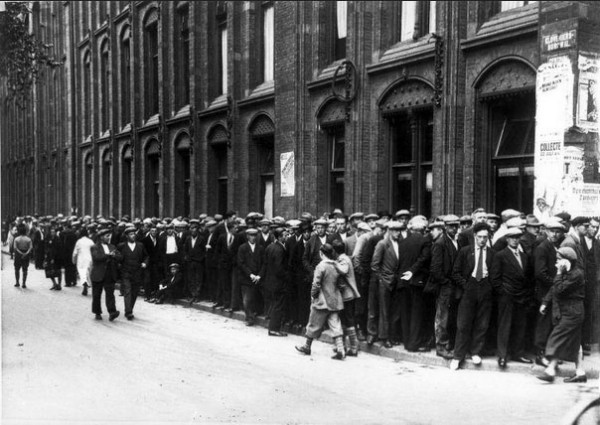
Mass unemployment 1933
Unemployment has been a major economic problem in advanced economies. One of the principal causes of unemployment is swings in the business cycle. A fall in demand for goods during a recession, causes people to be laid off. Because of the depressed state of the economy, there is an imbalance between demand and supply of workers.
Unemployment can also be caused by rapid changes in labour markets, for examples, unskilled workers unable to gain employment in a high tech economy. Unemployment is a problem because it is a waste of resources, but more importantly, it leads to very high personal costs, such as stress, alienation, low income and feelings of failure.
A recession is a period of negative economic growth – a decline in the size of the economy. It exacerbates problems of inequality and unemployment. A problem of recession is that it can create a negative spiral. When demand falls, firms lay off workers. The unemployed have less money to spend causing further falls in demand.
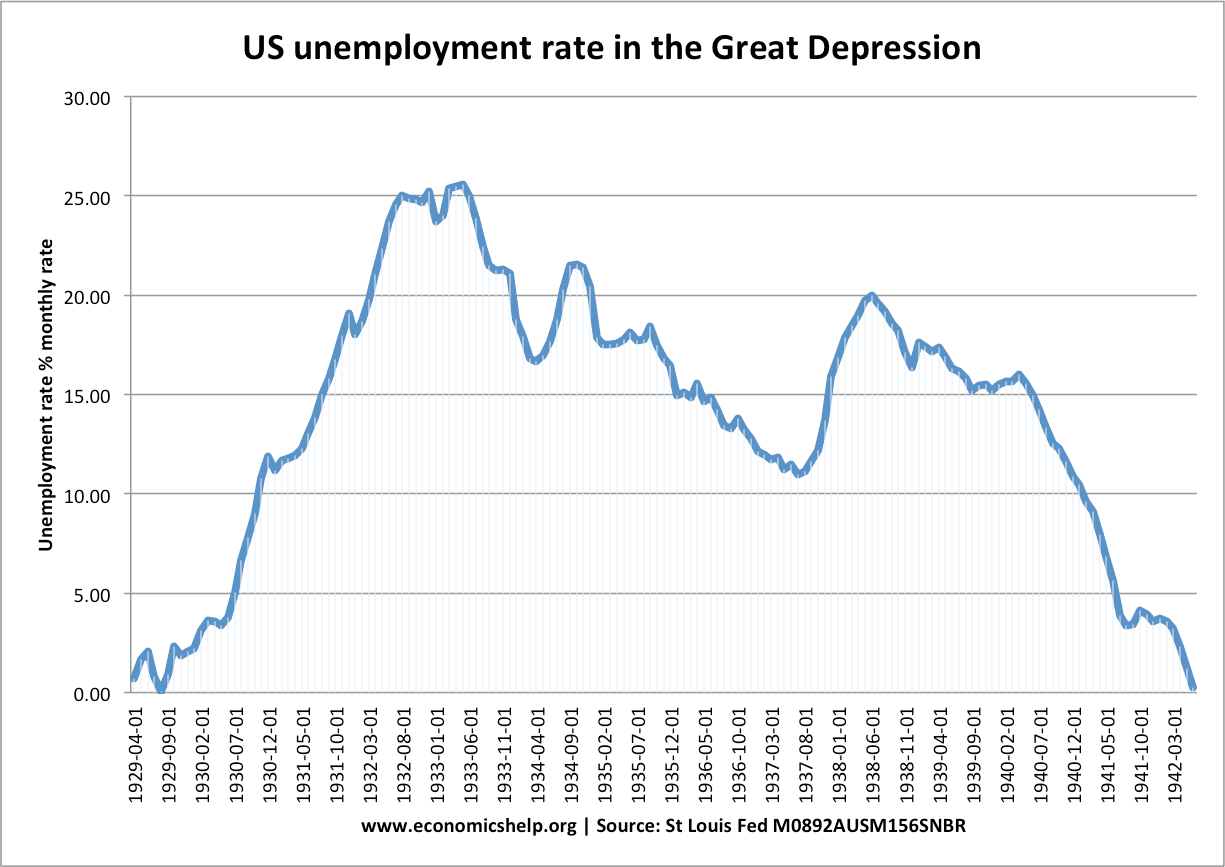
In the great depression, unemployment rose to over 20% – the unemployed also had little support and relied on soup kitchens.
High inflation can be a serious problem if prices rise faster than wages and nominal interest rates. In periods of rapidly rising prices, people with savings will see a decline in their real wealth. If prices rise faster than wages, then people’s spending power will decline. Also, rapidly rising prices creates confusion and uncertainty and can cause firms to cut back on investment and spending.
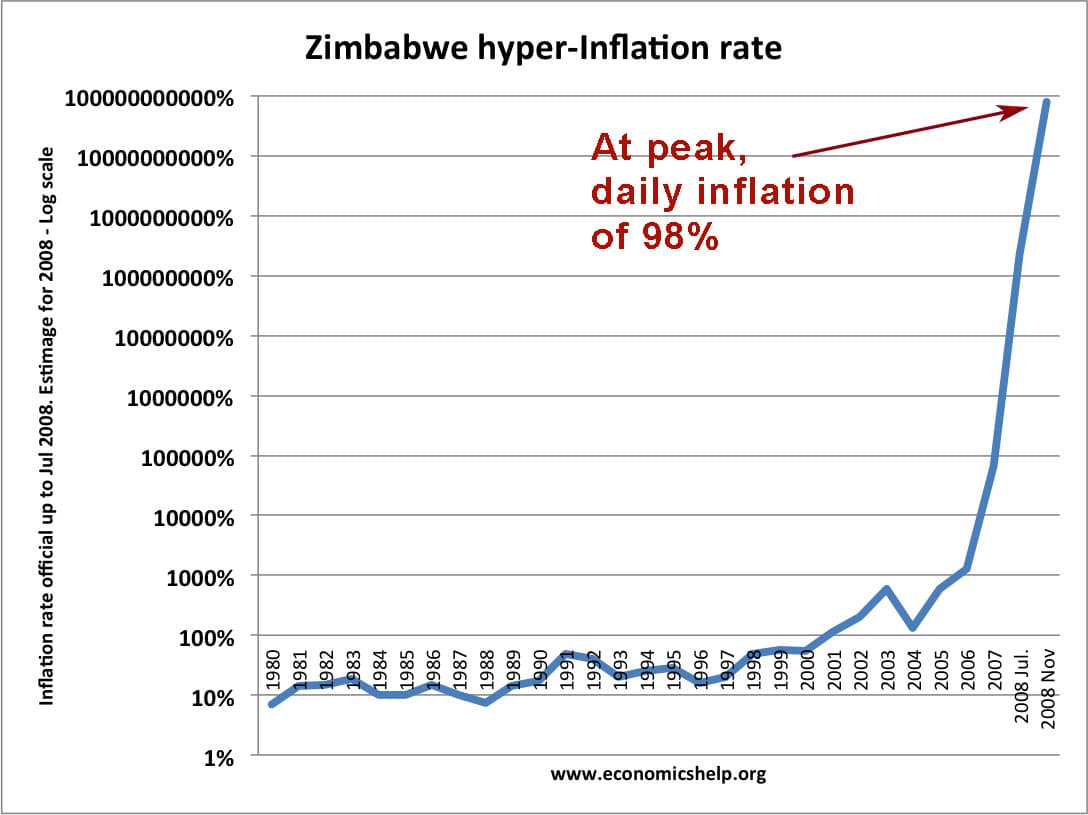
Countries which have experienced hyperinflation , have seen it as a very traumatic period because all the economic certainty is washed away, leaving people without any certainty. Hyper inflation can cause not just economic turmoil but political turmoil as people lose confidence in the economic situation of the economy.
Balance of payments/current account deficit
A current account deficit on the balance of payments means an economy is importing more goods and services than it is exporting. To finance this current account deficit, they need a surplus on the financial/capital account. For many modern economies, a small current account deficit is not a problem. However, some developing economies have experienced a balance of payments crisis – where the large deficit has to be financed by borrowing, and this situation usually leads to a rapid devaluation of the currency. But, this devaluation increases the price of imports, reduces living standards and causes inflation.
Exchange rate volatility
In some cases, the exchange rate can cause economic problems. For example, countries in the Euro were not able to change the value of their currency against other Eurozone members. Because countries like Greece and Portugal had higher inflation rates, they became uncompetitive. Exports fell, and they developed a large current account deficit. The overvalued exchange rate caused a fall in economic growth.
On the other hand, a rapid devaluation can cause different problems. For example, when the price of oil fell, oil exporting countries saw a decline in export revenues, leading to a fall in the value of the currency. A rapid devaluation causes the price of imports to rise and causes both higher inflation and lower growth. A difficult problem for policymakers to deal with.
Development economics
Developing economies face similar economic problems, but any issue is magnified by low GDP and high levels of poverty. For example, unemployment in a developing economy is more serious because there is unlikely to be any government insurance to give a minimum standard of living.
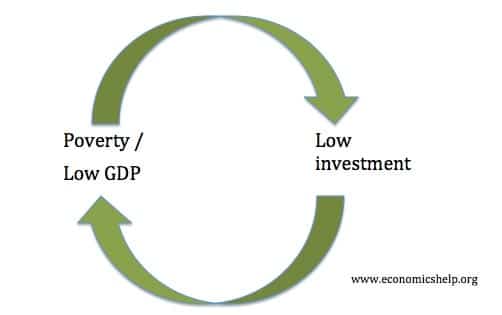
Poverty cycle . Some developing economies may be stuck in a poverty trap. Low growth and low saving ratios lead to low levels of investment and therefore low economic growth. This low growth and poverty cause the low savings and investment to be continued.
More examples
- Problems facing UK economy in 2015
- Economic problems of EU
Last updated: 17th November 2019, Tejvan Pettinger , www.economicshelp.org, Oxford, UK
28 thoughts on “Examples of economic problems”
Scarcity in resource is all over. It could be jobs, skills, capital, land, medicines, equipment, hospitals, universities, schools, houses, food, water etc
Sorry…it is not yet….
Enjoyed the lesson
what does economic mean
That is economic factors are addressed
Can I buy printed materials of this article Economic problems
Hi, Pettinger!
Really nice article, thank you. However, I am not sure I’ve got something you stated: isn’t inequality a macroeconomics issue? Because, you see, the scope of microeconomics is restricted to the individual actions of the economic agents (i.e., the “invisible hand science”) and inequality can only be properly handled by a macroeconomics perspective – or, at least, that’s the way I see it. Can you clarify that, please?
P.S.: if you are interested, I’ve answered this same question at stackexchange ( https://economics.stackexchange.com/questions/41448/is-inequality-a-micro-or-macro-economics-issue )
Govt.is also responsible for inequality , unemployment and low GDP growth by not taking efficient decisions in order to boost the economy.
Comments are closed.
Suggestions or feedback?
MIT News | Massachusetts Institute of Technology
- Machine learning
- Social justice
- Black holes
- Classes and programs
Departments
- Aeronautics and Astronautics
- Brain and Cognitive Sciences
- Architecture
- Political Science
- Mechanical Engineering
Centers, Labs, & Programs
- Abdul Latif Jameel Poverty Action Lab (J-PAL)
- Picower Institute for Learning and Memory
- Lincoln Laboratory
- School of Architecture + Planning
- School of Engineering
- School of Humanities, Arts, and Social Sciences
- Sloan School of Management
- School of Science
- MIT Schwarzman College of Computing
The power of economics to explain and shape the world
Press contact :.

Previous image Next image
Nobel Prize-winning economist Esther Duflo sympathizes with students who have no interest in her field. She was such a student herself — until an undergraduate research post gave her the chance to learn first-hand that economists address many of the major issues facing human and planetary well-being. “Most people have a wrong view of what economics is. They just see economists on television discussing what’s going to happen to the stock market,” says Duflo, the Abdul Latif Jameel Professor of Poverty Alleviation and Development Economics. “But what people do in the field is very broad. Economists grapple with the real world and with the complexity that goes with it.”
That’s why this year Duflo has teamed up with Professor Abhijit Banerjee to offer 14.009 (Economics and Society’s Greatest Problems), a first-year discovery subject — a class type designed to give undergraduates a low-pressure, high-impact way to explore a field. In this case, they are exploring the range of issues that economists engage with every day: the economic dimensions of climate change, international trade, racism, justice, education, poverty, health care, social preferences, and economic growth are just a few of the topics the class covers. “We think it’s pretty important that the first exposure to economics is via issues,” Duflo says. “If you first get exposed to economics via models, these models necessarily have to be very simplified, and then students get the idea that economics is a simplistic view of the world that can’t explain much.” Arguably, Duflo and Banerjee have been disproving that view throughout their careers. In 2003, the pair founded MIT’s Abdul Latif Jameel Poverty Action Lab, a leading antipoverty research network that provides scientific evidence on what methods actually work to alleviate poverty — which enables governments and nongovernmental organizations to implement truly effective programs and social policies. And, in 2019 they won the Nobel Prize in economics (together with Michael Kremer of the University of Chicago) for their innovative work applying laboratory-style randomized, controlled trials to research a wide range of topics implicated in global poverty. “Super cool”
First-year Jean Billa, one of the students in 14.009, says, “Economics isn’t just about how money flows, but about how people react to certain events. That was an interesting discovery for me.”
It’s also precisely the lesson Banerjee and Duflo hoped students would take away from 14.009, a class that centers on weekly in-person discussions of the professors’ recorded lectures — many of which align with chapters in Banerjee and Duflo’s book “Good Economics for Hard Times” (Public Affairs, 2019). Classes typically start with a poll in which the roughly 100 enrolled students can register their views on that week’s topic. Then, students get to discuss the issue, says senior Dina Atia, teaching assistant for the class. Noting that she finds it “super cool” that Nobelists are teaching MIT’s first-year students, Atia points out that both Duflo and Banerjee have also made themselves available to chat with students after class. “They’re definitely extending themselves,” she says. “We want the students to get excited about economics so they want to know more,” says Banerjee, the Ford Foundation International Professor of Economics, “because this is a field that can help us address some of the biggest problems society faces.” Using natural experiments to test theories
Early in the term, for example, the topic was migration. In the lecture, Duflo points out that migration policies are often impacted by the fear that unskilled migrants will overwhelm a region, taking jobs from residents and demanding social services. Yet, migrant flows in normal years represent just 3 percent of the world population. “There is no flood. There is no vast movement of migrants,” she says. Duflo then explains that economists were able to learn a lot about migration thanks to a “natural experiment,” the Mariel boat lift. This 1980 event brought roughly 125,000 unskilled Cubans to Florida over a matter a months, enabling economists to study the impacts of a sudden wave of migration. Duflo says a look at real wages before and after the migration showed no significant impacts. “It was interesting to see that most theories about immigrants were not justified,” Billa says. “That was a real-life situation, and the results showed that even a massive wave of immigration didn’t change work in the city [Miami].”
Question assumptions, find the facts in data Since this is a broad survey course, there is always more to unpack. The goal, faculty say, is simply to help students understand the power of economics to explain and shape the world. “We are going so fast from topic to topic, I don’t expect them to retain all the information,” Duflo says. Instead, students are expected to gain an appreciation for a way of thinking. “Economics is about questioning everything — questioning assumptions you don’t even know are assumptions and being sophisticated about looking at data to uncover the facts.” To add impact, Duflo says she and Banerjee tie lessons to current events and dive more deeply into a few economic studies. One class, for example, focused on the unequal burden the Covid-19 pandemic has placed on different demographic groups and referenced research by Harvard University professor Marcella Alsan, who won a MacArthur Fellowship this fall for her work studying the impact of racism on health disparities.
Duflo also revealed that at the beginning of the pandemic, she suspected that mistrust of the health-care system could prevent Black Americans from taking certain measures to protect themselves from the virus. What she discovered when she researched the topic, however, was that political considerations outweighed racial influences as a predictor of behavior. “The lesson for you is, it’s good to question your assumptions,” she told the class. “Students should ideally understand, by the end of class, why it’s important to ask questions and what they can teach us about the effectiveness of policy and economic theory,” Banerjee says. “We want people to discover the range of economics and to understand how economists look at problems.”
Story by MIT SHASS Communications Editorial and design director: Emily Hiestand Senior writer: Kathryn O'Neill
Share this news article on:
Related links.
- Class 14.009 (Economics and Society’s Greatest Problems)
- Esther Duflo
- Abhijit Banerjee
- Abdul Latif Jameel Poverty Action Lab
- Department of Economics
- Video: "Lighting the Path"
Related Topics
- Education, teaching, academics
- Climate change
- Immigration
- Health care
- School of Humanities Arts and Social Sciences
Related Articles

Popular new major blends technical skills and human-centered applications

Report: Economics drives migration from Central America to the U.S.

MIT economists Esther Duflo and Abhijit Banerjee win Nobel Prize
Previous item Next item
More MIT News

MIT researchers discover “neutronic molecules”
Read full story →

A new computational technique could make it easier to engineer useful proteins

Designing solutions to ensure equity in health care

Training manufacturing technologists to be future shop floor leaders
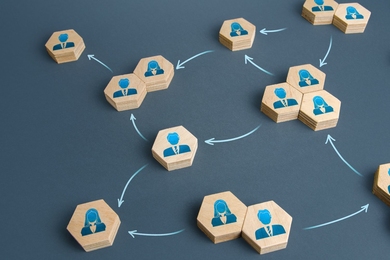
Characterizing social networks

MIT economics to launch new predoctoral fellowship program
- More news on MIT News homepage →
Massachusetts Institute of Technology 77 Massachusetts Avenue, Cambridge, MA, USA
- Map (opens in new window)
- Events (opens in new window)
- People (opens in new window)
- Careers (opens in new window)
- Accessibility
- Social Media Hub
- MIT on Facebook
- MIT on YouTube
- MIT on Instagram
A | The Use of Mathematics in Principles of Economics
(This appendix should be consulted after first reading Welcome to Economics! ) Economics is not math. There is no important concept in this course that cannot be explained without mathematics. That said, math is a tool that can be used to illustrate economic concepts. Remember the saying a picture is worth a thousand words? Instead of a picture, think of a graph. It is the same thing. Economists use models as the primary tool to derive insights about economic issues and problems. Math is one way of working with (or manipulating) economic models.
There are other ways of representing models, such as text or narrative. But why would you use your fist to bang a nail, if you had a hammer? Math has certain advantages over text. It disciplines your thinking by making you specify exactly what you mean. You can get away with fuzzy thinking in your head, but you cannot when you reduce a model to algebraic equations. At the same time, math also has disadvantages. Mathematical models are necessarily based on simplifying assumptions, so they are not likely to be perfectly realistic. Mathematical models also lack the nuances which can be found in narrative models. The point is that math is one tool, but it is not the only tool or even always the best tool economists can use. So what math will you need for this book? The answer is: little more than high school algebra and graphs. You will need to know:
- What a function is
- How to interpret the equation of a line (i.e., slope and intercept)
- How to manipulate a line (i.e., changing the slope or the intercept)
- How to compute and interpret a growth rate (i.e., percentage change)
- How to read and manipulate a graph
In this text, we will use the easiest math possible, and we will introduce it in this appendix. So if you find some math in the book that you cannot follow, come back to this appendix to review. Like most things, math has diminishing returns. A little math ability goes a long way; the more advanced math you bring in, the less additional knowledge that will get you. That said, if you are going to major in economics, you should consider learning a little calculus. It will be worth your while in terms of helping you learn advanced economics more quickly.
Algebraic Models
Often economic models (or parts of models) are expressed in terms of mathematical functions. What is a function? A function describes a relationship. Sometimes the relationship is a definition. For example (using words), your professor is Adam Smith. This could be expressed as Professor = Adam Smith. Or Friends = Bob + Shawn + Margaret.
Often in economics, functions describe cause and effect. The variable on the left-hand side is what is being explained (“the effect”). On the right-hand side is what is doing the explaining (“the causes”). For example, suppose your GPA was determined as follows:
This equation states that your GPA depends on three things: your combined SAT score, your class attendance, and the number of hours you spend studying. It also says that study time is twice as important (0.50) as either combined_SAT score (0.25) or class_attendance (0.25). If this relationship is true, how could you raise your GPA? By not skipping class and studying more. Note that you cannot do anything about your SAT score, since if you are in college, you have (presumably) already taken the SATs.
Of course, economic models express relationships using economic variables, like Budget = money_spent_on_econ_books + money_spent_on_music, assuming that the only things you buy are economics books and music.
Most of the relationships we use in this course are expressed as linear equations of the form:
Expressing Equations Graphically
Graphs are useful for two purposes. The first is to express equations visually, and the second is to display statistics or data. This section will discuss expressing equations visually.
To a mathematician or an economist, a variable is the name given to a quantity that may assume a range of values. In the equation of a line presented above, x and y are the variables, with x on the horizontal axis and y on the vertical axis, and b and m representing factors that determine the shape of the line. To see how this equation works, consider a numerical example:
In this equation for a specific line, the b term has been set equal to 9 and the m term has been set equal to 3. Table A1 shows the values of x and y for this given equation. Figure A1 shows this equation, and these values, in a graph. To construct the table, just plug in a series of different values for x, and then calculate what value of y results. In the figure, these points are plotted and a line is drawn through them.
This example illustrates how the b and m terms in an equation for a straight line determine the shape of the line. The b term is called the y-intercept. The reason for this name is that, if x = 0, then the b term will reveal where the line intercepts, or crosses, the y-axis. In this example, the line hits the vertical axis at 9. The m term in the equation for the line is the slope. Remember that slope is defined as rise over run; more specifically, the slope of a line from one point to another is the change in the vertical axis divided by the change in the horizontal axis. In this example, each time the x term increases by one (the run), the y term rises by three. Thus, the slope of this line is three. Specifying a y-intercept and a slope—that is, specifying b and m in the equation for a line—will identify a specific line. Although it is rare for real-world data points to arrange themselves as an exact straight line, it often turns out that a straight line can offer a reasonable approximation of actual data.
Interpreting the Slope
The concept of slope is very useful in economics, because it measures the relationship between two variables. A positive slope means that two variables are positively related; that is, when x increases, so does y, or when x decreases, y decreases also. Graphically, a positive slope means that as a line on the line graph moves from left to right, the line rises. The length-weight relationship, shown in Figure A3 later in this Appendix, has a positive slope. We will learn in other chapters that price and quantity supplied have a positive relationship; that is, firms will supply more when the price is higher.
A negative slope means that two variables are negatively related; that is, when x increases, y decreases, or when x decreases, y increases. Graphically, a negative slope means that, as the line on the line graph moves from left to right, the line falls. The altitude-air density relationship, shown in Figure A4 later in this appendix, has a negative slope. We will learn that price and quantity demanded have a negative relationship; that is, consumers will purchase less when the price is higher.
A slope of zero means that there is no relationship between x and y. Graphically, the line is flat; that is, zero rise over the run. Figure A5 of the unemployment rate, shown later in this appendix, illustrates a common pattern of many line graphs: some segments where the slope is positive, other segments where the slope is negative, and still other segments where the slope is close to zero.
The slope of a straight line between two points can be calculated in numerical terms. To calculate slope, begin by designating one point as the “starting point” and the other point as the “end point” and then calculating the rise over run between these two points. As an example, consider the slope of the air density graph between the points representing an altitude of 4,000 meters and an altitude of 6,000 meters:
Rise: Change in variable on vertical axis (end point minus original point)
Run: Change in variable on horizontal axis (end point minus original point)
Thus, the slope of a straight line between these two points would be that from the altitude of 4,000 meters up to 6,000 meters, the density of the air decreases by approximately 0.1 kilograms/cubic meter for each of the next 1,000 meters.
Suppose the slope of a line were to increase. Graphically, that means it would get steeper. Suppose the slope of a line were to decrease. Then it would get flatter. These conditions are true whether or not the slope was positive or negative to begin with. A higher positive slope means a steeper upward tilt to the line, while a smaller positive slope means a flatter upward tilt to the line. A negative slope that is larger in absolute value (that is, more negative) means a steeper downward tilt to the line. A slope of zero is a horizontal flat line. A vertical line has an infinite slope.
Suppose a line has a larger intercept. Graphically, that means it would shift out (or up) from the old origin, parallel to the old line. If a line has a smaller intercept, it would shift in (or down), parallel to the old line.
Solving Models with Algebra
Economists often use models to answer a specific question, like: What will the unemployment rate be if the economy grows at 3% per year? Answering specific questions requires solving the “system” of equations that represent the model.
Suppose the demand for personal pizzas is given by the following equation:
where Qd is the amount of personal pizzas consumers want to buy (i.e., quantity demanded), and P is the price of pizzas. Suppose the supply of personal pizzas is:
where Qs is the amount of pizza producers will supply (i.e., quantity supplied).
Finally, suppose that the personal pizza market operates where supply equals demand, or
We now have a system of three equations and three unknowns (Qd, Qs, and P), which we can solve with algebra:
Since Qd = Qs, we can set the demand and supply equation equal to each other:
Subtracting 2 from both sides and adding 2P to both sides yields:
In other words, the price of each personal pizza will be $2. How much will consumers buy?
Taking the price of $2, and plugging it into the demand equation, we get:
So if the price is $2 each, consumers will purchase 12. How much will producers supply? Taking the price of $2, and plugging it into the supply equation, we get:
So if the price is $2 each, producers will supply 12 personal pizzas. This means we did our math correctly, since Qd = Qs.
Solving Models with Graphs
If algebra is not your forte, you can get the same answer by using graphs. Take the equations for Qd and Qs and graph them on the same set of axes as shown in Figure A2 . Since P is on the vertical axis, it is easiest if you solve each equation for P. The demand curve is then P = 8 – 0.5Qd and the supply curve is P = –0.4 + 0.2Qs. Note that the vertical intercepts are 8 and –0.4, and the slopes are –0.5 for demand and 0.2 for supply. If you draw the graphs carefully, you will see that where they cross (Qs = Qd), the price is $2 and the quantity is 12, just like the algebra predicted.
We will use graphs more frequently in this book than algebra, but now you know the math behind the graphs.
Growth Rates
Growth rates are frequently encountered in real world economics. A growth rate is simply the percentage change in some quantity. It could be your income. It could be a business’s sales. It could be a nation’s GDP. The formula for computing a growth rate is straightforward:
Suppose your job pays $10 per hour. Your boss, however, is so impressed with your work that he gives you a $2 per hour raise. The percentage change (or growth rate) in your pay is $2/$10 = 0.20 or 20%.
To compute the growth rate for data over an extended period of time, for example, the average annual growth in GDP over a decade or more, the denominator is commonly defined a little differently. In the previous example, we defined the quantity as the initial quantity—or the quantity when we started. This is fine for a one-time calculation, but when we compute the growth over and over, it makes more sense to define the quantity as the average quantity over the period in question, which is defined as the quantity halfway between the initial quantity and the next quantity. This is harder to explain in words than to show with an example. Suppose a nation’s GDP was $1 trillion in 2005 and $1.03 trillion in 2006. The growth rate between 2005 and 2006 would be the change in GDP ($1.03 trillion – $1.00 trillion) divided by the average GDP between 2005 and 2006 ($1.03 trillion + $1.00 trillion)/2. In other words:
Note that if we used the first method, the calculation would be ($1.03 trillion – $1.00 trillion) / $1.00 trillion = 3% growth, which is approximately the same as the second, more complicated method. If you need a rough approximation, use the first method. If you need accuracy, use the second method.
A few things to remember: A positive growth rate means the quantity is growing. A smaller growth rate means the quantity is growing more slowly. A larger growth rate means the quantity is growing more quickly. A negative growth rate means the quantity is decreasing.
The same change over times yields a smaller growth rate. If you got a $2 raise each year, in the first year the growth rate would be $2/$10 = 20%, as shown above. But in the second year, the growth rate would be $2/$12 = 0.167 or 16.7% growth. In the third year, the same $2 raise would correspond to a $2/$14 = 14.2%. The moral of the story is this: To keep the growth rate the same, the change must increase each period.
Displaying Data Graphically and Interpreting the Graph
Graphs are also used to display data or evidence. Graphs are a method of presenting numerical patterns. They condense detailed numerical information into a visual form in which relationships and numerical patterns can be seen more easily. For example, which countries have larger or smaller populations? A careful reader could examine a long list of numbers representing the populations of many countries, but with over 200 nations in the world, searching through such a list would take concentration and time. Putting these same numbers on a graph can quickly reveal population patterns. Economists use graphs both for a compact and readable presentation of groups of numbers and for building an intuitive grasp of relationships and connections.
Three types of graphs are used in this book: line graphs, pie graphs, and bar graphs. Each is discussed below. We also provide warnings about how graphs can be manipulated to alter viewers’ perceptions of the relationships in the data.
Line Graphs
The graphs we have discussed so far are called line graphs , because they show a relationship between two variables: one measured on the horizontal axis and the other measured on the vertical axis.
Sometimes it is useful to show more than one set of data on the same axes. The data in Table A2 is displayed in Figure A3 which shows the relationship between two variables: length and median weight for American baby boys and girls during the first three years of life. (The median means that half of all babies weigh more than this and half weigh less.) The line graph measures length in inches on the horizontal axis and weight in pounds on the vertical axis. For example, point A on the figure shows that a boy who is 28 inches long will have a median weight of about 19 pounds. One line on the graph shows the length-weight relationship for boys and the other line shows the relationship for girls. This kind of graph is widely used by healthcare providers to check whether a child’s physical development is roughly on track.
Not all relationships in economics are linear. Sometimes they are curves. Figure A4 presents another example of a line graph, representing the data from Table A3 . In this case, the line graph shows how thin the air becomes when you climb a mountain. The horizontal axis of the figure shows altitude, measured in meters above sea level. The vertical axis measures the density of the air at each altitude. Air density is measured by the weight of the air in a cubic meter of space (that is, a box measuring one meter in height, width, and depth). As the graph shows, air pressure is heaviest at ground level and becomes lighter as you climb. Figure A4 shows that a cubic meter of air at an altitude of 500 meters weighs approximately one kilogram (about 2.2 pounds). However, as the altitude increases, air density decreases. A cubic meter of air at the top of Mount Everest, at about 8,828 meters, would weigh only 0.023 kilograms. The thin air at high altitudes explains why many mountain climbers need to use oxygen tanks as they reach the top of a mountain.
The length-weight relationship and the altitude-air density relationships in these two figures represent averages. If you were to collect actual data on air pressure at different altitudes, the same altitude in different geographic locations will have slightly different air density, depending on factors like how far you are from the equator, local weather conditions, and the humidity in the air. Similarly, in measuring the height and weight of children for the previous line graph, children of a particular height would have a range of different weights, some above average and some below. In the real world, this sort of variation in data is common. The task of a researcher is to organize that data in a way that helps to understand typical patterns. The study of statistics, especially when combined with computer statistics and spreadsheet programs, is a great help in organizing this kind of data, plotting line graphs, and looking for typical underlying relationships. For most economics and social science majors, a statistics course will be required at some point.
One common line graph is called a time series , in which the horizontal axis shows time and the vertical axis displays another variable. Thus, a time series graph shows how a variable changes over time. Figure A5 shows the unemployment rate in the United States since 1975, where unemployment is defined as the percentage of adults who want jobs and are looking for a job, but cannot find one. The points for the unemployment rate in each year are plotted on the graph, and a line then connects the points, showing how the unemployment rate has moved up and down since 1975. The line graph makes it easy to see, for example, that the highest unemployment rate during this time period was slightly less than 10% in the early 1980s and 2010, while the unemployment rate declined from the early 1990s to the end of the 1990s, before rising and then falling back in the early 2000s, and then rising sharply during the recession from 2008–2009.
A pie graph (sometimes called a pie chart ) is used to show how an overall total is divided into parts. A circle represents a group as a whole. The slices of this circular “pie” show the relative sizes of subgroups.
Figure A6 shows how the U.S. population was divided among children, working age adults, and the elderly in 1970, 2000, and what is projected for 2030. The information is first conveyed with numbers in Table A4 , and then in three pie charts. The first column of Table A4 shows the total U.S. population for each of the three years. Columns 2–4 categorize the total in terms of age groups—from birth to 18 years, from 19 to 64 years, and 65 years and above. In columns 2–4, the first number shows the actual number of people in each age category, while the number in parentheses shows the percentage of the total population comprised by that age group.
In a pie graph, each slice of the pie represents a share of the total, or a percentage. For example, 50% would be half of the pie and 20% would be one-fifth of the pie. The three pie graphs in Figure A6 show that the share of the U.S. population 65 and over is growing. The pie graphs allow you to get a feel for the relative size of the different age groups from 1970 to 2000 to 2030, without requiring you to slog through the specific numbers and percentages in the table. Some common examples of how pie graphs are used include dividing the population into groups by age, income level, ethnicity, religion, occupation; dividing different firms into categories by size, industry, number of employees; and dividing up government spending or taxes into its main categories.
A bar graph uses the height of different bars to compare quantities. Table A5 lists the 12 most populous countries in the world. Figure A7 provides this same data in a bar graph. The height of the bars corresponds to the population of each country. Although you may know that China and India are the most populous countries in the world, seeing how the bars on the graph tower over the other countries helps illustrate the magnitude of the difference between the sizes of national populations.
Bar graphs can be subdivided in a way that reveals information similar to that we can get from pie charts. Figure A8 offers three bar graphs based on the information from Figure A6 about the U.S. age distribution in 1970, 2000, and 2030. Figure A8 (a) shows three bars for each year, representing the total number of persons in each age bracket for each year. Figure A8 (b) shows just one bar for each year, but the different age groups are now shaded inside the bar. In Figure A8 (c), still based on the same data, the vertical axis measures percentages rather than the number of persons. In this case, all three bar graphs are the same height, representing 100% of the population, with each bar divided according to the percentage of population in each age group. It is sometimes easier for a reader to run their eyes across several bar graphs, comparing the shaded areas, rather than trying to compare several pie graphs.
Figure A7 and Figure A8 show how the bars can represent countries or years, and how the vertical axis can represent a numerical or a percentage value. Bar graphs can also compare size, quantity, rates, distances, and other quantitative categories.
Comparing Line Graphs with Pie Charts and Bar Graphs
Now that you are familiar with pie graphs, bar graphs, and line graphs, how do you know which graph to use for your data? Pie graphs are often better than line graphs at showing how an overall group is divided. However, if a pie graph has too many slices, it can become difficult to interpret.
Bar graphs are especially useful when comparing quantities. For example, if you are studying the populations of different countries, as in Figure A7 , bar graphs can show the relationships between the population sizes of multiple countries. Not only can it show these relationships, but it can also show breakdowns of different groups within the population.
A line graph is often the most effective format for illustrating a relationship between two variables that are both changing. For example, time series graphs can show patterns as time changes, like the unemployment rate over time. Line graphs are widely used in economics to present continuous data about prices, wages, quantities bought and sold, the size of the economy.
How Graphs Can Be Misleading
Graphs not only reveal patterns; they can also alter how patterns are perceived. To see some of the ways this can be done, consider the line graphs of Figure A9 , Figure A10 , and Figure A11 . These graphs all illustrate the unemployment rate—but from different perspectives.
Suppose you wanted a graph which gives the impression that the rise in unemployment in 2009 was not all that large, or all that extraordinary by historical standards. You might choose to present your data as in Figure A9 (a). Figure A9 (a) includes much of the same data presented earlier in Figure A5 , but stretches the horizontal axis out longer relative to the vertical axis. By spreading the graph wide and flat, the visual appearance is that the rise in unemployment is not so large, and is similar to some past rises in unemployment. Now imagine you wanted to emphasize how unemployment spiked substantially higher in 2009. In this case, using the same data, you can stretch the vertical axis out relative to the horizontal axis, as in Figure A9 (b), which makes all rises and falls in unemployment appear larger.
A similar effect can be accomplished without changing the length of the axes, but by changing the scale on the vertical axis. In Figure A10 (c), the scale on the vertical axis runs from 0% to 30%, while in Figure A10 (d), the vertical axis runs from 3% to 10%. Compared to Figure A5 , where the vertical scale runs from 0% to 12%, Figure A10 (c) makes the fluctuation in unemployment look smaller, while Figure A10 (d) makes it look larger.
Another way to alter the perception of the graph is to reduce the amount of variation by changing the number of points plotted on the graph. Figure A10 (e) shows the unemployment rate according to five-year averages. By averaging out some of the year-to-year changes, the line appears smoother and with fewer highs and lows. In reality, the unemployment rate is reported monthly, and Figure A11 (f) shows the monthly figures since 1960, which fluctuate more than the five-year average. Figure A11 (f) is also a vivid illustration of how graphs can compress lots of data. The graph includes monthly data since 1960, which over almost 50 years, works out to nearly 600 data points. Reading that list of 600 data points in numerical form would be hypnotic. You can, however, get a good intuitive sense of these 600 data points very quickly from the graph.
A final trick in manipulating the perception of graphical information is that, by choosing the starting and ending points carefully, you can influence the perception of whether the variable is rising or falling. The original data show a general pattern with unemployment low in the 1960s, but spiking up in the mid-1970s, early 1980s, early 1990s, early 2000s, and late 2000s. Figure A11 (g), however, shows a graph that goes back only to 1975, which gives an impression that unemployment was more-or-less gradually falling over time until the 2009 recession pushed it back up to its “original” level—which is a plausible interpretation if one starts at the high point around 1975.
These kinds of tricks—or shall we just call them “presentation choices”— are not limited to line graphs. In a pie chart with many small slices and one large slice, someone must decide what categories should be used to produce these slices in the first place, thus making some slices appear bigger than others. If you are making a bar graph, you can make the vertical axis either taller or shorter, which will tend to make variations in the height of the bars appear more or less.
Being able to read graphs is an essential skill, both in economics and in life. A graph is just one perspective or point of view, shaped by choices such as those discussed in this section. Do not always believe the first quick impression from a graph. View with caution.
Key Concepts and Summary
Math is a tool for understanding economics and economic relationships can be expressed mathematically using algebra or graphs. The algebraic equation for a line is y = b + mx, where x is the variable on the horizontal axis and y is the variable on the vertical axis, the b term is the y-intercept and the m term is the slope. The slope of a line is the same at any point on the line and it indicates the relationship (positive, negative, or zero) between two economic variables.
Economic models can be solved algebraically or graphically. Graphs allow you to illustrate data visually. They can illustrate patterns, comparisons, trends, and apportionment by condensing the numerical data and providing an intuitive sense of relationships in the data. A line graph shows the relationship between two variables: one is shown on the horizontal axis and one on the vertical axis. A pie graph shows how something is allotted, such as a sum of money or a group of people. The size of each slice of the pie is drawn to represent the corresponding percentage of the whole. A bar graph uses the height of bars to show a relationship, where each bar represents a certain entity, like a country or a group of people. The bars on a bar graph can also be divided into segments to show subgroups.
Any graph is a single visual perspective on a subject. The impression it leaves will be based on many choices, such as what data or time frame is included, how data or groups are divided up, the relative size of vertical and horizontal axes, whether the scale used on a vertical starts at zero. Thus, any graph should be regarded somewhat skeptically, remembering that the underlying relationship can be open to different interpretations.
Review Questions
Name three kinds of graphs and briefly state when is most appropriate to use each type of graph.
What is slope on a line graph?
What do the slices of a pie chart represent?
Why is a bar chart the best way to illustrate comparisons?
How does the appearance of positive slope differ from negative slope and from zero slope?
As an Amazon Associate we earn from qualifying purchases.
This book may not be used in the training of large language models or otherwise be ingested into large language models or generative AI offerings without OpenStax's permission.
Want to cite, share, or modify this book? This book uses the Creative Commons Attribution License and you must attribute OpenStax.
Access for free at https://openstax.org/books/principles-economics-3e/pages/1-introduction
- Authors: Steven A. Greenlaw, David Shapiro, Daniel MacDonald
- Publisher/website: OpenStax
- Book title: Principles of Economics 3e
- Publication date: Dec 14, 2022
- Location: Houston, Texas
- Book URL: https://openstax.org/books/principles-economics-3e/pages/1-introduction
- Section URL: https://openstax.org/books/principles-economics-3e/pages/a-the-use-of-mathematics-in-principles-of-economics
© Jan 23, 2024 OpenStax. Textbook content produced by OpenStax is licensed under a Creative Commons Attribution License . The OpenStax name, OpenStax logo, OpenStax book covers, OpenStax CNX name, and OpenStax CNX logo are not subject to the Creative Commons license and may not be reproduced without the prior and express written consent of Rice University.
- Marketplace
- Marketplace Morning Report
- Marketplace Tech
- Make Me Smart
- This is Uncomfortable
- The Uncertain Hour
- How We Survive
- Financially Inclined
- Million Bazillion
- Marketplace Minute®
- Corner Office from Marketplace

- Latest Stories
- Collections
- Smart Speaker Skills
- Corrections
- Ethics Policy
- Submissions
- Individuals
- Corporate Sponsorship
- Foundations

How to problem-solve through economic issues

Share Now on:
- https://www.marketplace.org/2021/01/01/how-to-problem-solve-through-economic-issues/ COPY THE LINK
HTML EMBED:
Identifying problems, especially economic issues, can seem obvious. What’s harder is figuring out the constraints that prevent them from being solved. But there are ways to arrive at solutions.
It’s the subject of a new book, “The Economic Superorganism” by Carey King, a research scientist and assistant director of the Energy Institute at the University of Texas at Austin. He recently spoke with Marketplace’s Andy Uhler.
The following is an edited transcript of Uhler and King’s conversation.
Andy Uhler: So when we think of the traditional economic model of the energy industry, what does that model or what do those models get wrong?
Carey King: Well, my narratives in my book are a little bit more about macroeconomic narratives, or how do people approach what the economy is and how does it grow in general? And so I simplify into the techno optimistic narrative of infinite growth and substitutability of technologies. On the opposite end of that spectrum is technorealism. Which is to say, well, there are constraints in the world, there are things like physical laws that we understand. And there are constraints of time. And we need to take these into account to actually understand what’s possible and how the economy evolves. So those are really the two narratives and they get applied to the energy industry. And by applying them, I would say, less accurate narratives to how the energy system interacts with the broader economy. I think we get answers from reports and analyses that are less accurate than we can do.
Uhler: Because you’re talking about using the data to then ask different questions and also sort of come up with different narratives and ultimately, different answers. Right?
King: Right. So everybody’s kind of coming up with their own narratives. In my book, the narratives are in some sense, strawmen, but they’re set up so that I can then go into detail about well, here’s a coherent way to think about what the economy is. And one of those ways is to say that the economy is an organism, like living organisms that need energy and resources to grow. It needs energy and resource consumption to maintain itself. And it has to distribute these resources internally. So by taking these kinds of physical aspects into account, we have a better interpretation for the economic patterns that we see.
Andy Uhler: I’m curious sort of how your model fits with this new shift in renewable energy. And in sort of the way that we think about zero carbon as well, how does it fit?
King: So a lot of the shift of the energy system and other industries in general is to lower marginal cost in general. So you might have higher capital costs, which we take into account or when we think about things like solar and photovoltaic systems and batteries, they have a high upfront capital cost, lower marginal cost. And this is essentially the same kind of growth pattern we see in biology and ecosystems in the sense that the last bits of growth of an animal consume less energy than the previous set. So it’s a similar pattern that we might see in ecosystems.
Stories You Might Like

OPEC has to decide whether it will continue to curb oil output

How will the world respond to the European Union’s proposed carbon border tax?
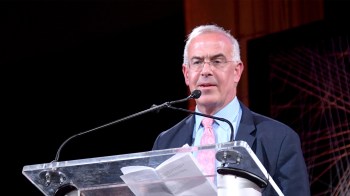
David Brooks on what’s responsible for America’s class divisions

There’s a new website publishing news stories in Texas. It’s run by Chevron.

What we get wrong about the energy grid

How fantasy football became a billion-dollar industry
There’s a lot happening in the world. Through it all, Marketplace is here for you.
You rely on Marketplace to break down the world’s events and tell you how it affects you in a fact-based, approachable way. We rely on your financial support to keep making that possible.
Your donation today powers the independent journalism that you rely on . For just $5/month, you can help sustain Marketplace so we can keep reporting on the things that matter to you.
Latest Episodes From Our Shows

Small businesses have Now Hiring signs up — whether they need workers or not

New FTC rule aims to crack down on impersonation scams

Affordability is key for the latest wave of car shoppers. Can carmakers keep up?
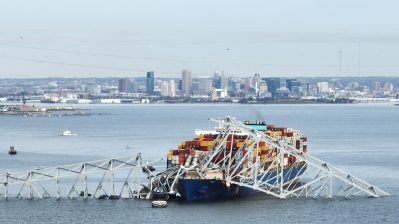
Who will pay for the Key Bridge collapse?
Browse Course Material
Course info.
- Prof. Jonathan Gruber
Departments
As taught in.
- Microeconomics
Learning Resource Types
Principles of microeconomics, problem set 1.
« Previous | Next »
Preparation
The problem set is comprised of challenging questions that test your understanding of the material covered in the course. Make sure you have mastered the concepts and problem solving techniques from the following sessions before attempting the problem set:
- Introduction to Microeconomics
- Applying Supply and Demand
Problem Set and Solutions
- Problem Set Questions (PDF)
- Problem Set Solutions (PDF)
Problem Solving Video
In the video below, a teaching assistant demonstrates his approach to the solution for problems 1 and 4 from the problem set. The teaching assistant notes common mistakes made by students and provides problem solving techniques for approaching similar questions on the problem set and exams.
- Download video
- Download transcript

You are leaving MIT OpenCourseWare
Final dates! Join the tutor2u subject teams in London for a day of exam technique and revision at the cinema. Learn more →
Reference Library
Collections
- See what's new
- All Resources
- Student Resources
- Assessment Resources
- Teaching Resources
- CPD Courses
- Livestreams
Study notes, videos, interactive activities and more!
Economics news, insights and enrichment
Currated collections of free resources
Browse resources by topic
- All Economics Resources
Resource Selections
Currated lists of resources
Study Notes
What is the fundamental economic problem?
Last updated 13 Jul 2023
- Share on Facebook
- Share on Twitter
- Share by Email
The basic economic problem, also known as the fundamental economic problem, refers to the scarcity of resources in relation to the unlimited wants and needs of individuals and societies. It is the central issue in economics and arises due to the imbalance between what people desire and the resources available to fulfill those desires.
In essence, the basic economic problem can be summarized by three key questions:
- What to produce: Since resources are limited, societies must decide what goods and services to produce and in what quantities. This involves making choices about which products or services are most needed or desired by the population.
- How to produce: Once the decision on what to produce is made, societies must determine the most efficient and effective methods of production. This involves deciding on the combination of resources to use, such as labor, capital, and technology, to produce the desired goods and services.
- For whom to produce: After determining what and how to produce, societies need to allocate the produced goods and services to different individuals and groups. This raises questions about the distribution of resources and the equitable allocation of goods and services among the population.
The basic economic problem arises from the reality of scarcity. Resources such as land, labor, capital, and natural resources are limited, while human wants and needs are virtually unlimited. As a result, individuals, businesses, and societies must make choices and trade-offs to allocate resources efficiently, optimize production, and satisfy the most pressing needs and desires.
Economics as a social science discipline seeks to study and analyse the basic economic problem and develop theories and models to understand how societies make decisions regarding resource allocation, production, and distribution in the face of scarcity.
Here are some of the ways that economic systems try to address the fundamental economic problem:
- Market economies: Market economies are based on the principle of supply and demand. Prices are determined by the interaction of buyers and sellers in the market. This system allows for the efficient allocation of resources, but it can also lead to inequality and environmental problems.
- Planned (command) economies: Planned economies are based on the principle of central planning. The government decides what goods and services will be produced and how resources will be allocated. This system can ensure that everyone's basic needs are met, but it can also be inefficient and inflexible.
- Mixed economies: Mixed economies combine elements of market economies and planned economies. The government plays a role in the economy, but it also allows for some degree of free market activity. This system is often seen as a way to balance the efficiency of market economies with the equity of planned economies.
The fundamental economic problem is a complex issue that has no easy solutions. However, different economic systems offer different approaches to addressing the problem.
- Water Scarcity
- Scarcity bias
- Resource Scarcity
- Opportunity cost
You might also like
Opportunity cost, the problem of scarcity, scarce resources, choices and economic systems.
Teaching PowerPoints
Venezuela – fingerprinting as a rationing device.
26th August 2014

Scarcity and Abundance
25th September 2013
Scarcity and Choices
What are the main factors of production, production possibility frontier, our subjects.
- › Criminology
- › Economics
- › Geography
- › Health & Social Care
- › Psychology
- › Sociology
- › Teaching & learning resources
- › Student revision workshops
- › Online student courses
- › CPD for teachers
- › Livestreams
- › Teaching jobs
Boston House, 214 High Street, Boston Spa, West Yorkshire, LS23 6AD Tel: 01937 848885
- › Contact us
- › Terms of use
- › Privacy & cookies
© 2002-2024 Tutor2u Limited. Company Reg no: 04489574. VAT reg no 816865400.

- ⋮⋮⋮ ×
Using Documented Problem Solving in Economics

Documented problem solving has been used effectively in Principles of Economics courses at a large, public, research institution over the last few years. It's been used with the topics of production possibilities, supply and demand, price elasticity and consumer demand, market structures, the labor market, unemployment, fiscal and monetary policy, GDP per capita and economic growth, effective tax rates, international trade plus many more. Clearly, it can be applied to virtually any economics course. Students find the process challenging at first, but because the process itself is not graded, they soon relax and enjoy it as a tool that serves to enhance their learning process.
Documented Problem Solving Fosters Development of Critical Thinking and Problem-Solving Skills
Angelo & Cross (1993, p. 222) write "To become truly proficient problem solvers, students need to learn to do more than just get correct answers to textbook problems. At some point, they need to become aware of how they solved those problems and how they can adapt their problem-solving routines to deal with messy, real-world problems. . . Understanding and using effective problem-solving procedures is, after all, a critical component of mastery in most disciplines." Documented problem solving requires students to reflect on how they solve a problem and then write down the steps they use.
As students describe how they break an economic problem down into small, basic steps, they frequently write:
- First, I reviewed the definition of...
- I opened my notes to the section on...
- The first thing my group thought about was...
- I remembered the graph you drew and...
- The directions say to find where the...
- According to the equation...
- I read the question and then I read it again...
Thus, documented problem solving provides a window through which the instructor can see students' thinking processes. It is rewarding for instructors to see students become more purposeful and deliberate in their approach to solving problems and to even develop problem-solving patterns that can be transferred to other areas in economics and other fields of study. Through the use of documented problem solving, students become more efficient learners; more expert-like in their thinking process.
Documented Problem Solving - Question Types
Documented problem solving works well with multiple choice, true/false and short answer questions. Questions from test banks will typically work and are readily available. Alternatively, faculty may choose to write their own questions. Questions do not need to be overly challenging in order to be suitable for documented problem solving, but they must require a multi-step thought process in order to arrive at the answer.
Economics questions that work well with this approach are those that:
- Require students to follow a predictable path to arrive at the correct answer.
- Involve calculations and require students to select the proper equation to use.
- Include data and require students to interpret it.
- Challenge students to think beyond what was delivered in the lecture or discussed in the text.
- Require students to combine several independent concepts or ideas to achieve the correct answer.
- Address topics that students typically struggle with.
A suitable economic question that students can write a documented problem solution for because it requires a multi-step process.
For product XYZ, the price elasticity of demand has an absolute value of 3. Ceteris paribus , this means that quantity demanded will increase by:
a) 1 percent for each 3 percent decrease in price. b) 1 unit for each $3 decrease in price.
c) 3 percent for each 1 percent decrease in price. d) 3 units for each $1 decrease in price.
Student's answer: First I opened my notes to read the definition for price elasticity of demand. Price elasticity measures the change in quantity demanded because of a change in price. The formula is (% change in quantity demanded) ÷ (% change in price). So for the answer to be 3, 3 goes on top (% change in quantity demanded) and 1 goes on bottom (% change in price). The real number is negative 3 because price and quantity demanded move in opposite directions. For this question, if price goes up by 1%, the quantity demanded goes down by 3%. Then I looked at the answer choices to see which one matched. If price goes down by 1%, then quantity demanded will go up by 3%, so c is the correct answer.
Economics questions that don't work well with this approach
Definition-type questions and questions that ask students to pick from a list are not good choices if they merely require students to recall memorized information. In such a case, there are no multiple steps for the student to describe. Remember, one of the primary reasons for using documented problem solving is to help students breakdown their solution process into individual steps which will ultimately assist them in developing analytical and critical thinking skills.
An unsuitable economic question that students cannot write a documented problem solution for because no problem-solving skills are required.
Which of the following countries produces the most output each year?
a) China b) United States c) Russia d) Mexico
Student's answer: The United States because that's what the table in the text says.
However, given that much of economics relies on analytical reasoning, it is easy to find plenty of questions that are appropriate.
Getting started with documented problem solving
The majority of the information that is needed to begin using documented problem solving is presented beginning with the Main page of this module.
« Previous Page Next Page »
Solution to the Basic Economic Problems: Capitalistic, Socialistic and Mixed Economy
Solution to the Basic Economic Problems: Capitalistic, Socialistic and Mixed Economy!
Uneven distribution of natural resources, lack of human specialization and technological advancement etc., hinders the production of goods and services in an economy. Every economy has to face the problems of what to produce, how to produce and for whom to produce. More or less, all the economies use two important methods to solve these basic problems.
These methods are:
(a) Free price mechanism and
ADVERTISEMENTS:
(b) Controlled price system or State intervention.
Price mechanism is defined as a system of guiding and coordinating the decisions of every individual unit within an economy through the price determined with the help of the free play of market forces of demand and supply. Such system is free from state intervention.
Price of goods and services are determined when quantity demanded becomes equal to the quantity supplied. Price mechanism facilitates determination of resource allocation, determination of factor incomes, level of savings, consumption and production. Price mechanism basically takes place in a capitalistic economy.
On the other hand, Controlled price mechanism is defined as a system of state interventio n of administering or fixing the prices of the goods and services. In a socialist economy, the government plays a vital role in determining the price of the goods and services. The government may introduce ‘ceiling price’ or ‘floor price’ policy to regulate prices.
However, how a capitalist, a socialist and a mixed economic system solve their basic problems is given below:
1. Solution to Basic Problems in a Capitalistic Economy:
Under capitalistic economy, allocation of various resources takes place with the help of market mechanism. Price of various goods and services including the price of factors of production are determined with help of the forces of demand and supply. Free price mechanism helps producers to decide what to produce.
The goods which are more in demand and on which consumers can afford to spend more, are produced in larger quantity than those goods or services which have lower demand. The price of various factors of production including technology helps to decide production techniques or methods of production. Rational producer intends to use those factors or techniques which has relatively lower price in the market.
Factor earnings received by the employers of factors of production decides spending capacity of the people. This helps producers to identify the consumers for whom goods could be produced in larger or smaller quantities. Price mechanism works well only if competition exists and natural flow of demand and supply of goods is not disturbed artificially.
2. Solution to Basic Problems in a Socialistic Economy:
Under socialistic economy, the government plays an important role in decision making. The government undertakes to plan, control and regulate all the major economic activities to solve the basic economic problems. All the major economic policies are formulated and implemented by the Central Planning Authority.
In India, Planning Commission was entrusted with this task of planning. The Planning Commission of India has now been replaced by another central authority NITI Ayog (National Institution for Transforming India). Therefore, the central planning authority takes the decisions to overcome the economic problems of what to produce, how to produce and for whom to produce.
The central planning authority decides the nature of goods and services to be produced as per available resources and the priority of the country. The allocation of resources is made in greater volume for those goods which are essential for the nation. The state’s main objectives are growth, equality and price stability. The government implements fiscal policies such as taxation policy, expenditure policy, public debt policy or policy on deficit financing in order to achieve the above objectives.
The methods of production or production techniques are also determined or selected by the central planning authority. The central planning authority decides whether labor intensive technique or capital intensive technique is to be used for the production. While deciding the appropriate method, social and economic conditions of the economy are taken into consideration.
Under socialistic economy, every government aims to achieve social justice through its actions. All economic resources are owned by the government. People can work for wages which are regulated by the government as per work efficiency. The income earned determines the aggregate demand in an economy. This helps the government in assessing the demand of goods and services by different income groups.
3. Solution to Basic Problems in a Mixed Economy:
Practically, neither capitalistic economy nor socialistic economy exists in totality. Both the economic systems have limitations. Consequently, a new system of economy has emerged as a blend of the above two systems called mixed economy. Therefore, mixed economy is defined as a system of economy where private sectors and public sectors co-exist and work side by side for the welfare of the country.
Under such economies, all economic problems are solved with the help of free price mechanism and controlled price mechanism (economic planning).
Free price mechanism operates within the private sector; hence, prices are allowed to change as per demand and supply of goods. Therefore, private sector can produce goods as per their demand and their price in the market. The government may control and regulate production of the private sector through its monetary policy or fiscal policy.
On the other hand, controlled price mechanism (economic planning) is used for the public sector by the planning authority. The goods and services to be produced in the public sector, hence, are determined by the central planning authority.
Private sector determines the production technique or production method on the basis of factor prices, availability of technology etc. On the other hand, production technique or production method for the public sector is determined by the central planning authority. While determining the production technique for the public sector, national priority, national employment policy and social objectives are major considerations.
Private sector allocates its resources to produce those goods which are demanded by people who command high purchasing power. Although, production by the private sector is sometimes controlled and regulated by the government through various policies such as licensing policy, taxation policy, subsidy etc., the price determined by free price mechanism may go beyond the purchasing power of low or marginal income group.
Therefore, the government may undertake production of certain goods in its hands. The rationing policy is also introduced to provide essential goods at reasonable price to the poor people. The government, thus, ensures social justice by its actions in the mixed economy.
Related Articles:
- Basic Problems of an Economy and Price Mechanism (FAQs)
- Mixed Economy: Meaning, Features and Types of Mixed Economy
- Price Mechanism: in Free, Socialistic and Mixed Economy
- 5 Basic Problems of an Economy (With Diagram)

- Our Initiatives
- Our Students
- Visit research portal >
Creating simple solutions for complex socio-economic problems
Giri Kesavan, MBA 2021, introduces his work with the Mash Foundation Trust and his upcoming talk at TEDx London Business School , ‘Simple solutions to complex problems.’ Drawing on his experiences working in microfinance and social impact in Kenya and Tanzania during his MBA, Giri explores how even the most complex socio-economic problems can be solved using simple, yet impactful, solutions.

‘Simplicity is the ultimate sophistication,’ Leonardo da Vinci.
As I finish my MBA programme at London Business School, what I’ve realised is that drilling down to the simplest form of the problem and tackling the root cause of solutions is absolutely vital. Yes, we can use detailed frameworks, analysis, metrics, tools and techniques – but fundamentally, we need to understand root-cause, and be frugal and adaptive in our solutions.
During the MBA I’ve been involved in a whole host of projects working with global companies, from Uganda to New York to London to Kenya! These international projects and experiences across multiple sectors and business areas have highlighted how startlingly similar root causes actually are. Indeed, looking back on my own experiences before London Business School with a ‘post MBA’ lens, it’s been an interesting thought process to reflect on how to distil a complex problem into its simplest form.
Over the past few years I’ve been working with The MASH Foundation Trust , working with the founder, Charles Macharia, on how to bring economic empowerment through education in Kenya. It’s a complex problem! How can we solve it?
Fundamentally, looking at even the most complex issue, the broad themes and areas of contention can be distilled into the following:
- Resource: Ah the classic management question. How can we do more with less ? In a highly resource constrained world with competing priorities, focusing on the fundamental problem and gearing resources towards that area is key. Throwing money at a problem isn’t the solution. Being frugal and innovative with what you have is!
- Time: Everyone wants everything yesterday. One of the challenges we faced in Kenya was how to manage time, prioritise and ensure incremental delivery day by day was always aligned to the main objectives of the organisation. Very often, in the rush to deliver, we forget how to sync bottoms-up initiatives with top-down strategy – and that’s absolutely vital to optimising time and energy.
- Relationships: Effective stakeholder management and communication is key. During my projects, this aspect of doing business, especially in an emerging economy with multiple competing interests and stakeholder groups, was always a thorny issue. Being transparent in communication, adapting the message to your audience and crucially, managing expectations is pivotal.
Very often, across the three dimensions above, businesses can create innovative and simple solutions to counteract roadblocks and obstacles to success. This year it’s an honour to be selected to speak at TEDx London Business School – and in my TEDx talk I’ll be going through scenarios of how even complex socio-economic problems can be solved through simple, and yet impactful, solutions.
Listen to Giri’s talk as part of TEDx London Business School. On 2&4 February, the much anticipated TEDxLondonBusinessSchool 2021 live broadcast will return for its 10th anniversary. Join to embark on a journey of inspiration, thrill and adventure under this year’s theme of ‘Mind the Gap’. Meet and mingle with TED enthusiasts from around the globe, and get inspired by our talks. Find out more at: https://tedxlondonbusinessschool.co.uk/
Giri Kesavan (MBA2021) is Co-President of The Tech & Media Club at London Business School. An MBA2021 student, he also chairs the degree & careers wide Technology Sector Steering Committee, working with the school, faculty, industry, alumni and Careers Centre on Technology education & careers. Giri works with The Wheeler Institute on content development, outreach and student-led collaborations. He is further involved with the school as an MBA Academic Representative and Peer Leader for Technology.
The Wheeler Institute is seeking to understand, illuminate and offer solutions to the challenges faced by the developing world, with an aim to identify the role of business in addressing these challenges and a focus on the implications and actions for those in developing countries. In support of our students, we approach this blog section as a reflective platform and a space where individuals can generate debate as long term agents of positive change.
Solver Title
Generating PDF...
- Pre Algebra Order of Operations Factors & Primes Fractions Long Arithmetic Decimals Exponents & Radicals Ratios & Proportions Percent Modulo Number Line Mean, Median & Mode
- Algebra Equations Inequalities System of Equations System of Inequalities Basic Operations Algebraic Properties Partial Fractions Polynomials Rational Expressions Sequences Power Sums Interval Notation Pi (Product) Notation Induction Logical Sets Word Problems
- Pre Calculus Equations Inequalities Scientific Calculator Scientific Notation Arithmetics Complex Numbers Polar/Cartesian Simultaneous Equations System of Inequalities Polynomials Rationales Functions Arithmetic & Comp. Coordinate Geometry Plane Geometry Solid Geometry Conic Sections Trigonometry
- Calculus Derivatives Derivative Applications Limits Integrals Integral Applications Integral Approximation Series ODE Multivariable Calculus Laplace Transform Taylor/Maclaurin Series Fourier Series Fourier Transform
- Functions Line Equations Functions Arithmetic & Comp. Conic Sections Transformation
- Linear Algebra Matrices Vectors
- Trigonometry Identities Proving Identities Trig Equations Trig Inequalities Evaluate Functions Simplify
- Statistics Mean Geometric Mean Quadratic Mean Average Median Mode Order Minimum Maximum Probability Mid-Range Range Standard Deviation Variance Lower Quartile Upper Quartile Interquartile Range Midhinge Standard Normal Distribution
- Physics Mechanics
- Chemistry Chemical Reactions Chemical Properties
- Finance Simple Interest Compound Interest Present Value Future Value
- Economics Point of Diminishing Return
- Conversions Roman Numerals Radical to Exponent Exponent to Radical To Fraction To Decimal To Mixed Number To Improper Fraction Radians to Degrees Degrees to Radians Hexadecimal Scientific Notation Distance Weight Time Volume
- Pre Algebra
- Pre Calculus
- Linear Algebra
- Trigonometry
- Point of Diminishing Return
- Conversions

Most Used Actions
Number line.
- point\:of\:diminishing\:return\:11000-x^{3}+36x^{2}+700x
- point\:of\:diminishing\:return\:-x^{3}+42x^{2}+1100,\:0\le x\le19
- point\:of\:diminishing\:return\:r(x)=-x^3+48x^2+1000
- point\:of\:diminishing\:return\:-\frac{3}{7}(x^3-7x-7)
economics-calculator
- Practice Makes Perfect Learning math takes practice, lots of practice. Just like running, it takes practice and dedication. If you want...
Please add a message.
Message received. Thanks for the feedback.
- Privacy Policy
- Terms & Conditions

Home » Others » Economics » Basic Economic Problems and Their Solutions
Basic Economic Problems and Their Solutions
Economics grapples with several fundamental problems that affect every society, regardless of its level of development. These problems revolve around the allocation of limited resources to meet the ever-expanding needs and wants of individuals and society as a whole.
Table of Contents
The basic economic problems which come up to be automatically settled through the role of price mechanism are as under:
- How are the productive resources allocated
- How is the level of production determined?
- How is national product distributed?
- How is the capacity of the economy maintained / developed
Scarcity of Resources
Scarcity is perhaps the most basic economic problem. Resources, including land, labor, capital, and natural resources, are limited. On the other hand, human wants and needs are virtually unlimited. This creates a scarcity problem because there are not enough resources to produce all the goods and services people desire.
See Also: B.COM Economics Notes in PDF
Solution: While scarcity cannot be eliminated, it can be managed. Economies prioritize the allocation of resources through systems like market prices, central planning, or a combination of both. The key is to use resources efficiently by producing goods and services that provide the most value to society.
Choice and Opportunity Cost
Due to scarcity, individuals and societies face choices. When resources are allocated to produce one good or service, they cannot be used to produce another. This leads to the concept of opportunity cost, which is the value of the next best alternative given up when a choice is made.
Solution: Making informed choices is vital. Individuals and policymakers must consider the opportunity cost of their decisions and allocate resources to maximize the overall well-being of society.

Unlimited Human Wants
Human wants and needs are practically limitless. As people’s living standards rise and new technologies emerge, their desires for goods and services grow.
Solution: While wants may be limitless, societies need to prioritize needs and allocate resources to fulfill them. This requires effective resource management and policy decisions.
Distribution of Income and Wealth
Economic systems must address issues of income inequality and wealth distribution. Some individuals and groups may accumulate substantial wealth, while others have limited access to resources and income.
Solution: There is no one-size-fits-all solution, but governments often use progressive taxation and social welfare programs to address income inequality. These policies aim to redistribute wealth and support those with fewer resources.
Achieving Economic Efficiency
Economies must strive for efficiency, where resources are used to maximize output and minimize waste. Inefficient resource allocation can lead to lower overall well-being.
Solution: Economic efficiency is often achieved through competition, which incentivizes producers to minimize costs and offer high-quality products. Regulatory bodies and government policies can also play a role in promoting efficiency.
Full Employment
One of the economic objectives is to achieve full employment, meaning that all willing and able workers are employed. Unemployment can lead to lost output and societal issues.
Solution: Governments implement various policies, such as job training programs and labor market regulations, to promote employment. Additionally, fostering economic growth can create more job opportunities.
Price Stability
Inflation, which is a sustained increase in the general price level, can erode the purchasing power of money. Deflation, on the other hand, can lead to economic stagnation. Achieving price stability is a fundamental challenge.
Central banks often have the mandate to maintain price stability by adjusting interest rates and implementing monetary policies. These actions aim to control inflation and deflation.
Economic Growth
Economic growth is essential to improve living standards and meet the increasing needs of a growing population. However, achieving sustainable growth is a complex challenge.
To foster economic growth, governments and businesses invest in education, infrastructure, and research and development. Promoting innovation and productivity gains is crucial for sustainable growth.
Environmental Sustainability
The global economy’s impact on the environment poses a significant problem. Economic activities, if unchecked, can lead to environmental degradation and resource depletion.
Solution: Sustainable development and responsible resource management are key solutions. Policymakers and businesses are increasingly focusing on eco-friendly practices and renewable resources.
Quality of Life and Well-Being
Economics is not only about the quantity of goods and services but also the quality of life and well-being. A narrow focus on economic growth may neglect other important aspects of human welfare.
Solution: Economists are developing new indicators like the Human Development Index (HDI) and Gross National Happiness (GNH) to measure well-being beyond mere economic metrics. Policymakers are looking at broader social and environmental goals to enhance overall quality of life.
Allocation of Resources
Productive resources can be alternatively used. They can either be used to produce agricultural commodities or they can be diverted to produce industrial Where will the resources be allocated?
Solution: This problem is automatically solved by the role of price mechanism in a capitalist society.
For example, if the prices of industrial goods are rising relative to agricultural commodities, entrepreneurs will prefer to make investment in the industrial sector in an attempt to achieve maximum profit.
For this purpose, they will offer higher rewards to factors of production in order to attract them in the industrial sector. Naturally more resources will be allocated in the industrial sector than agriculture.
Determination of Level of Production
What should be the level of output to be produced by a firm? This problem also is solved by the role of the price mechanism in a laissez-faire economy.
The quantity of output to be produced depends on the demand for it and also on its supply which is determined by the amount of capital required to produce it.
The products which are locally demanded are produced at a small scale. Entrepreneurs determine the level of their output to be produced with a view to maximize profits.
The profit is maximized only when the marginal revenue (MR) of the additional or last unit of output sold is equal to marginal cost (MC) of the additional unit of output produced. When MR= MC the output produced by a firm is automatically determined.
Distribution of Output
How is national product distributed among different sections of society? This problem is also solved by the role of price mechanism in a capitalist society.
Each factor of production is paid according to its marginal revenue product (MRP) which, particularly in a third world country, leads to unequal distribution of wealth.
For fair distribution of wealth, monetary and fiscal measures are required to be adopted and in this regard Govt. intervention can be justified in the Keynesian sense.
Maintaining Productive Capacity of the Economy
Classical economists, who uphold micro economic policies, believe that there is always full employment in the economy of a country and whenever there are lapses from full employment.
There will always be an automatic tendency to restore the stationary equilibrium at full employment. Hence there is no question of overproduction and general unemployment in a laissez-faire economy.
Therefore, to maintain or develop the productive capacity of the economy, abundant or cheaper factor of production is required to be employed more than the relatively scarce and expensive factor.
For example, if it is a labor abundant economy, labor intensive technique of production will suit more and if it is a capital abundant economy, capital-intensive techniques would be required to maintain the productive capacity of the economy.
The basic economic problems of scarcity, choice, and resource allocation require ongoing management and solutions to balance competing interests and fulfill societal needs. These solutions often involve a combination of market forces, government policies, and individual choices to promote economic efficiency, equality, and the overall well-being of society.
See Also: Economics is a Science as Well as an Art
Search Here...

Exogenous Growth Theory | Definition | Components | Importance | Limitations

What is Deflation | Causes | Types | How to Control it

What is Balance of Payments | Components | Types | Strategies | Challenges

What is Economic Development | Components | Strategies | Challenges

Differences between Economic Growth and Economic Development
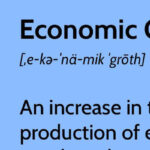
What is Economic Growth | Importance | Types | Indicators | Factors | Criticism
Popular terms:.
- Financial Management (13)
- Human Resource Management (36)
- Organizational Behavior (14)
- Principles of Marketing (33)
- Auditing (28)
- Business Communication (44)
- Business Law (25)
- Economics (58)
- Introduction to Business (30)
- Money and Banking (30)
Related Posts

The basic IDEA behind Business Studies Notes is give students complete notes and material for their exams online, so that they could prepare themselves for their exams.
Students like DBA , BBA , MBA , D.COM, B.COM and M.COM may easily get ready for their exams online by visiting us here at businessstudiesnotes.com .
Recent Posts
Quick links.
MA in American History : Apply now and enroll in graduate courses with top historians this summer!
- AP US History Study Guide
- History U: Courses for High School Students
- History School: Summer Enrichment
- Lesson Plans
- Classroom Resources
- Spotlights on Primary Sources
- Professional Development (Academic Year)
- Professional Development (Summer)
- Book Breaks
- Inside the Vault
- Self-Paced Courses
- Browse All Resources
- Search by Issue
- Search by Essay
- Become a Member (Free)
- Monthly Offer (Free for Members)
- Program Information
- Scholarships and Financial Aid
- Applying and Enrolling
- Eligibility (In-Person)
- EduHam Online
- Hamilton Cast Read Alongs
- Official Website
- Press Coverage
- Veterans Legacy Program
- The Declaration at 250
- Black Lives in the Founding Era
- Celebrating American Historical Holidays
- Browse All Programs
- Donate Items to the Collection
- Search Our Catalog
- Research Guides
- Rights and Reproductions
- See Our Documents on Display
- Bring an Exhibition to Your Organization
- Interactive Exhibitions Online
- About the Transcription Program
- Civil War Letters
- Founding Era Newspapers
- College Fellowships in American History
- Scholarly Fellowship Program
- Richard Gilder History Prize
- David McCullough Essay Prize
- Affiliate School Scholarships
- Nominate a Teacher
- Eligibility
- State Winners
- National Winners
- Gilder Lehrman Lincoln Prize
- Gilder Lehrman Military History Prize
- George Washington Prize
- Frederick Douglass Book Prize
- Our Mission and History
- Annual Report
- Contact Information
- Student Advisory Council
- Teacher Advisory Council
- Board of Trustees
- Remembering Richard Gilder
- President's Council
- Scholarly Advisory Board
- Internships
- Our Partners
- Press Releases
History Resources

How Hamilton Solved the Economic Problems Facing the United States
By fred raphael, lesson overview.
In this lesson students will develop an understanding of the economic challenges facing the newly independent United States. Those challenges included the lack of a national currency, the national government’s inability to levy taxes, and the crushing war debt. Through analyzing primary sources students will learn how Alexander Hamilton, first secretary of the treasury, addressed these issues.
Lesson Objectives
Students will be able to
- Discuss the economic challenges facing the early United States
- Make inferences about the difficulties of running a country without a stable currency
- Analyze Hamilton’s plans to solve economic problems in the United States
Number of Class Periods
One 45-minute class period
Grade Level
5th–8th grades
Common Core State Standards
CCSS.ELA-LITERACY.RI.5.2 CCSS.ELA-LITERACY.RI.5.3 CCSS.ELA-LITERACY.RI.5.10
Essential Question
To what extent did Alexander Hamilton’s policies on a national mint and manufacturing strengthen the American economy?
Historical Background
After winning the American Revolution, the newly independent United States faced enormous challenges, particularly on economic issues. Alexander Hamilton believed that the federal government needed to play a much stronger role in the establishment of a national economic system. With the creation of institutions such as a national bank and a national mint, Hamilton sought to establish a system to allow a free flow of commerce within the United States and with foreign countries.
During the colonial era, each colony and bank could print their own currency. During the war and under the Articles of Confederation there were attempts to print a national currency and create a mint, but the efforts failed, and most legislators lost interest. When Alexander Hamilton took charge of the new Department of Treasury, one of his primary goals was to establish a national currency and a mint that would produce coins. This would rationalize payments across the United States and help build confidence around the world in the American economy.
In addition, Hamilton felt that the country needed to establish its own factories to produce goods such as clothing and tools. If Americans relied on manufactured goods from Europe, the economy could easily be destabilized and the US would not be truly independent. He believed that the US had to develop an economy based on agriculture, manufacturing, and commerce.
- Colonial currency from Pennsylvania, 1775. Source: The Gilder Lehrman Institute of American History, GLC01980.05.01
- Colonial currency from Delaware, 1776. Source: The Gilder Lehrman Institute of American History, GLC01980.05.03
- State currency from Rhode Island, 1786. Source: The Gilder Lehrman Institute of American History, GLC01980.05.02
- Excerpts from Alexander Hamilton’s Report on the Establishment of a Mint , January 28, 1791, The Gilder Lehrman Institute of American History, GLC01036
- Excerpts from Alexander Hamilton’s Report of the Secretary of the Treasury of the United States on the Subject of Manufactures , December 5, 1791, The Gilder Lehrman Institute of American History, GLC00891
- Why do you think we use paper money? Why not trade for what we want?
- How do you know that stores will accept your money?
- Do you think it’s good to have one currency for the whole country, or would it better to have each state have its own money?
- The class will discuss their answers as a whole class.
- Distribute the "Local Currencies" handout. The students will examine the images and answer the questions on the handout. They will discuss their answers to arrive at an understanding of the difficulties of using different currencies across the country.
- Explain that under the Articles of Confederation each state could print money, and there was no single currency that was accepted everywhere.
- Distribute the excerpts from Hamilton’s Report on the Establishment of a Mint and "share read" the text with the class. This is done by having the students follow along silently while you begin reading aloud, modeling prosody, inflection, and punctuation. Ask the class to join in with the reading after a few sentences while you continue to serve as the model for the class. This technique will support struggling readers as well as English language learners (ELL).
- Divide the class into pairs. Students will work with their partners to complete the questions that accompany the excerpts.
- Discuss economic conditions in the United States after the American Revolution. Focus on the fact that the country was primarily an agricultural nation although factories began to be established in the early 1790s.
- Distribute the excerpts from Hamilton’s Report . . . on the Subject of Manufactures . You may decide to share read the text with the class. Students will work with their partners to complete the questions.
- Discuss the answers as a class and encourage the students to ask each other questions about their selections and answers.
Assessment and Summary
Students will complete an exit card answering two questions:
- How do you think establishing a national mint and one standard currency helped the United States grow?
- List two positive and two negative effects of the growth of manufacturing.
Stay up to date, and subscribe to our quarterly newsletter.
Learn how the Institute impacts history education through our work guiding teachers, energizing students, and supporting research.
Government Budgets and Fiscal Policy
Practical problems with discretionary fiscal policy, learning objectives.
By the end of this section, you will be able to:
- Understand how fiscal policy and monetary policy are interconnected
- Explain the three lag times that often occur when solving economic problems
- Identify the legal and political challenges of responding to an economic problem
In the early 1960s, many leading economists believed that the problem of the business cycle, and the swings between cyclical unemployment and inflation, were a thing of the past. On the cover of its December 31, 1965, issue, Time magazine, then the premier news magazine in the United States, ran a picture of John Maynard Keynes , and the story inside identified Keynesian theories as “the prime influence on the world’s economies.” The article reported that policymakers have “used Keynesian principles not only to avoid the violent [business] cycles of prewar days but to produce phenomenal economic growth and to achieve remarkably stable prices.”
This happy consensus, however, did not last. The U.S. economy suffered one recession from December 1969 to November 1970, a deeper recession from November 1973 to March 1975, and then double-dip recessions from January to June 1980 and from July 1981 to November 1982. At various times, inflation and unemployment both soared. Clearly, the problems of macroeconomic policy had not been completely solved. As economists began to consider what had gone wrong, they identified a number of issues that make discretionary fiscal policy more difficult than it had seemed in the rosy optimism of the mid-1960s.
Fiscal Policy and Interest Rates
Because fiscal policy affects the quantity that the government borrows in financial capital markets , it not only affects aggregate demand—it can also affect interest rates. In [link] , the original equilibrium (E 0 ) in the financial capital market occurs at a quantity of $800 billion and an interest rate of 6%. However, an increase in government budget deficits shifts the demand for financial capital from D 0 to D 1 . The new equilibrium (E 1 ) occurs at a quantity of $900 billion and an interest rate of 7%.
A consensus estimate based on a number of studies is that an increase in budget deficits (or a fall in budget surplus) by 1% of GDP will cause an increase of 0.5–1.0% in the long-term interest rate.

Fiscal Policy and Interest Rates. When a government borrows money in the financial capital market, it causes a shift in the demand for financial capital from D0 to D1. As the equilibrium moves from E0 to E1, the equilibrium interest rate rises from 6% to 7% in this example. In this way, an expansionary fiscal policy intended to shift aggregate demand to the right can also lead to a higher interest rate, which has the effect of shifting aggregate demand back to the left.
A problem arises here. An expansionary fiscal policy, with tax cuts or spending increases, is intended to increase aggregate demand. If an expansionary fiscal policy also causes higher interest rates, then firms and households are discouraged from borrowing and spending (as occurs with tight monetary policy), thus reducing aggregate demand. Even if the direct effect of expansionary fiscal policy on increasing demand is not totally offset by lower aggregate demand from higher interest rates, fiscal policy can end up less powerful than was originally expected. We refer to this as crowding out , where government borrowing and spending results in higher interest rates, which reduces business investment and household consumption.
The broader lesson is that the government must coordinate fiscal and monetary policy. If expansionary fiscal policy is to work well, then the central bank can also reduce or keep short-term interest rates low. Conversely, monetary policy can also help to ensure that contractionary fiscal policy does not lead to a recession.
Long and Variable Time Lags
The government can change monetary policy several times each year, but it takes much longer to enact fiscal policy. Imagine that the economy starts to slow down. It often takes some months before the economic statistics signal clearly that a downturn has started, and a few months more to confirm that it is truly a recession and not just a one- or two-month blip. Economists often call the time it takes to determine that a recession has occurred the recognition lag. After this lag, policymakers become aware of the problem and propose fiscal policy bills. The bills go into various congressional committees for hearings, negotiations, votes, and then, if passed, eventually for the president’s signature. Many fiscal policy bills about spending or taxes propose changes that would start in the next budget year or would be phased in gradually over time. Economists often refer to the time it takes to pass a bill as the legislative lag . Finally, once the government passes the bill it takes some time to disperse the funds to the appropriate agencies to implement the programs. Economists call the time it takes to start the projects the implementation lag .
Moreover, the exact level of fiscal policy that the government should implement is never completely clear. Should it increase the budget deficit by 0.5% of GDP? By 1% of GDP? By 2% of GDP? In an AD/AS diagram, it is straightforward to sketch an aggregate demand curve shifting to the potential GDP level of output. In the real world, we only know roughly, not precisely, the actual level of potential output, and exactly how a spending cut or tax increase will affect aggregate demand is always somewhat controversial. Also unknown is the state of the economy at any point in time. During the early days of the Obama administration, for example, no one knew the true extent of the economy’s deficit. During the 2008-2009 financial crisis, the rapid collapse of the banking system and automotive sector made it difficult to assess how quickly the economy was collapsing.
Thus, it can take many months or even more than a year to begin an expansionary fiscal policy after a recession has started—and even then, uncertainty will remain over exactly how much to expand or contract taxes and spending. When politicians attempt to use countercyclical fiscal policy to fight recession or inflation, they run the risk of responding to the macroeconomic situation of two or three years ago, in a way that may be exactly wrong for the economy at that time. George P. Schultz, a professor of economics, former Secretary of the Treasury, and Director of the Office of Management and Budget, once wrote: “While the economist is accustomed to the concept of lags, the politician likes instant results. The tension comes because, as I have seen on many occasions, the economist’s lag is the politician’s nightmare.”
Temporary and Permanent Fiscal Policy
A temporary tax cut or spending increase will explicitly last only for a year or two, and then revert to its original level. A permanent tax cut or spending increase is expected to stay in place for the foreseeable future. The effect of temporary and permanent fiscal policies on aggregate demand can be very different. Consider how you would react if the government announced a tax cut that would last one year and then be repealed, in comparison with how you would react if the government announced a permanent tax cut. Most people and firms will react more strongly to a permanent policy change than a temporary one.
This fact creates an unavoidable difficulty for countercyclical fiscal policy. The appropriate policy may be to have an expansionary fiscal policy with large budget deficits during a recession, and then a contractionary fiscal policy with budget surpluses when the economy is growing well. However, if both policies are explicitly temporary ones, they will have a less powerful effect than a permanent policy.
Structural Economic Change Takes Time
When an economy recovers from a recession, it does not usually revert to its exact earlier shape. Instead, the economy’s internal structure evolves and changes and this process can take time. For example, much of the economic growth of the mid-2000s was in the construction sector (especially of housing) and finance. However, when housing prices started falling in 2007 and the resulting financial crunch led into recession (as we discussed in Monetary Policy and Bank Regulation), both sectors contracted. The manufacturing sector of the U.S. economy has been losing jobs in recent years as well, under pressure from technological change and foreign competition. Many of the people who lost work from these sectors in the 2008-2009 Great Recession will never return to the same jobs in the same sectors of the economy. Instead, the economy will need to grow in new and different directions, as the following Clear It Up feature shows. Fiscal policy can increase overall demand, but the process of structural economic change—the expansion of a new set of industries and the movement of workers to those industries—inevitably takes time.
Why do jobs vanish?
People can lose jobs for a variety of reasons: because of a recession, but also because of longer-run changes in the economy, such as new technology. Productivity improvements in auto manufacturing, for example, can reduce the number of workers needed, and eliminate these jobs in the long run. The internet has created jobs but also caused job loss, from travel agents to book store clerks. Many of these jobs may never come back. Short-run fiscal policy to reduce unemployment can create jobs, but it cannot replace jobs that will never return.
The Limitations of Fiscal Policy
Fiscal policy can help an economy that is producing below its potential GDP to expand aggregate demand so that it produces closer to potential GDP, thus lowering unemployment. However, fiscal policy cannot help an economy produce at an output level above potential GDP without causing inflation At this point, unemployment becomes so low that workers become scarce and wages rise rapidly.
Visit this website to read about how fiscal policies are affecting the recovery.

Political Realties and Discretionary Fiscal Policy
A final problem for discretionary fiscal policy arises out of the difficulties of explaining to politicians how countercyclical fiscal policy that runs against the tide of the business cycle should work. Some politicians have a gut-level belief that when the economy and tax revenues slow down, it is time to hunker down, pinch pennies, and trim expenses. Countercyclical policy, however, says that when the economy has slowed, it is time for the government to stimulate the economy, raising spending, and cutting taxes. This offsets the drop in the economy in the other sectors. Conversely, when economic times are good and tax revenues are rolling in, politicians often feel that it is time for tax cuts and new spending. However, countercyclical policy says that this economic boom should be an appropriate time for keeping taxes high and restraining spending.
Politicians tend to prefer expansionary fiscal policy over contractionary policy. There is rarely a shortage of proposals for tax cuts and spending increases, especially during recessions. However, politicians are less willing to hear the message that in good economic times, they should propose tax increases and spending limits. In the economic upswing of the late 1990s and early 2000s, for example, the U.S. GDP grew rapidly. Estimates from respected government economic forecasters like the nonpartisan Congressional Budget Office and the Office of Management and Budget stated that the GDP was above potential GDP, and that unemployment rates were unsustainably low. However, no mainstream politician took the lead in saying that the booming economic times might be an appropriate time for spending cuts or tax increases. As of February 2017, President Trump has expressed plans to increase spending on national defense by 10% or $54 billion, increase infrastructure investment by $1 trillion, cut corporate and personal income taxes, all while maintaining the existing spending on Social Security and Medicare. The only way this math adds up is with a sizeable increase in the Federal budget deficit.
Discretionary Fiscal Policy: Summing Up
Expansionary fiscal policy can help to end recessions and contractionary fiscal policy can help to reduce inflation. Given the uncertainties over interest rate effects, time lags, temporary and permanent policies, and unpredictable political behavior, many economists and knowledgeable policymakers had concluded by the mid-1990s that discretionary fiscal policy was a blunt instrument, more like a club than a scalpel. It might still make sense to use it in extreme economic situations, like an especially deep or long recession. For less extreme situations, it was often preferable to let fiscal policy work through the automatic stabilizers and focus on monetary policy to steer short-term countercyclical efforts.
Key Concepts and Summary
Because fiscal policy affects the quantity of money that the government borrows in financial capital markets, it not only affects aggregate demand—it can also affect interest rates. If an expansionary fiscal policy also causes higher interest rates, then firms and households are discouraged from borrowing and spending, reducing aggregate demand in a situation called crowding out. Given the uncertainties over interest rate effects, time lags (implementation lag, legislative lag, and recognition lag), temporary and permanent policies, and unpredictable political behavior, many economists and knowledgeable policymakers have concluded that discretionary fiscal policy is a blunt instrument and better used only in extreme situations.
Self-Check Questions
What would happen if expansionary fiscal policy was implemented in a recession but, due to lag, did not actually take effect until after the economy was back to potential GDP?
Prices would be pushed up as a result of too much spending.
What would happen if contractionary fiscal policy were implemented during an economic boom but, due to lag, it did not take effect until the economy slipped into recession?
Employment would suffer as a result of too little spending.
Do you think the typical time lag for fiscal policy is likely to be longer or shorter than the time lag for monetary policy? Explain your answer?
Monetary policy probably has shorter time lags than fiscal policy. Imagine that the data becomes fairly clear that an economy is in or near a recession. Expansionary monetary policy can be carried out through open market operations, which can be done fairly quickly, since the Federal Reserve’s Open Market Committee meets six times a year. Also, monetary policy takes effect through interest rates, which can change fairly quickly. However, fiscal policy is carried out through acts of Congress that need to be signed into law by the president. Negotiating such laws often takes months, and even after the laws are negotiated, it takes more months for spending programs or tax cuts to have an effect on the macroeconomy.
Review Questions
What are some practical weaknesses of discretionary fiscal policy?
Critical Thinking Questions
What is a potential problem with a temporary tax increase designed to increase aggregate demand if people know that it is temporary?
If the government gives a $300 tax cut to everyone in the country, explain the mechanism by which this will cause interest rates to rise.
Leduc, Sylvain, and Daniel Wilson. Federal Reserve Bank of San Francisco: Working Paper Series. “Are State Governments Roadblocks to Federal Stimulus? Evidence from Highway Grants in the 2009 Recovery Act. (Working Paper 2013-16).” Last modified July 2013. http://www.frbsf.org/economic-research/files/wp2013-16.pdf.
Lucking, Brian, and Daniel Wilson. “FRBSF Economic Letter-Fiscal Headwinds: Is the Other Shoe About to Drop?” Federal Reserve Bank of San Francisco . Last modified June 3, 2013. http://www.frbsf.org/economic-research/publications/economic-letter/2013/june/fiscal-headwinds-federal-budget-policy/.
Recovery.gov. “Track the Money.” http://www.recovery.gov/Pages/default.aspx.
Bastagli, Francesca, David Coady, and Sanjeev Gupta. International Monetary Fund. “IMF Staff Discussion Note: Income Inequality and Fiscal Policy.” Last modified June 28, 2012. http://www.imf.org/external/pubs/ft/sdn/2012/sdn1208.pdf.
- Principles of Macroeconomics 2e. Provided by : OpenStax. Located at : http://cnx.org/contents/[email protected] . License : CC BY: Attribution . License Terms : Download for free at http://cnx.org/contents/[email protected]

Privacy Policy
StudyMonkey
Your personal ai economics tutor.
Learn Smarter, Not Harder with Economics AI
Introducing StudyMonkey, your AI-powered Economics tutor .
StudyMonkey AI can tutor complex Economics homework questions, enhance your essay writing and assess your work—all in seconds.
No more long all-nighters
24/7 solutions to Economics questions you're stumped on and essays you procrastinated on.
No more stress and anxiety
Get all your Economics assignments done with helpful answers in 10 seconds or less.
No more asking friends for Economics help
StudyMonkey is your new smart bestie that will never ghost you.
No more staying after school
AI Economics tutoring is available 24/7, on-demand when you need it most.
Economics is a social science that studies the production, distribution, and consumption of goods and services. It aims to explain how economies work and how economic agents interact.
AI Tutor for any subject
American college testing (act), anthropology, advanced placement exams (ap exams), arabic language, archaeology, biochemistry, chartered financial analyst (cfa) exam, communications, computer science, certified public accountant (cpa) exam, cultural studies, cyber security, dental admission test (dat), discrete mathematics, earth science, elementary school, entrepreneurship, environmental science, farsi (persian) language, fundamentals of engineering (fe) exam, gender studies, graduate management admission test (gmat), graduate record examination (gre), greek language, hebrew language, high school entrance exam, high school, human geography, human resources, international english language testing system (ielts), information technology, international relations, independent school entrance exam (isee), linear algebra, linguistics, law school admission test (lsat), machine learning, master's degree, medical college admission test (mcat), meteorology, microbiology, middle school, national council licensure examination (nclex), national merit scholarship qualifying test (nmsqt), number theory, organic chemistry, project management professional (pmp), political science, portuguese language, probability, project management, preliminary sat (psat), public policy, public relations, russian language, scholastic assessment test (sat), social sciences, secondary school admission test (ssat), sustainability, swahili language, test of english as a foreign language (toefl), trigonometry, turkish language, united states medical licensing examination (usmle), web development, step-by-step guidance 24/7.
Receive step-by-step guidance & homework help for any homework problem & any subject 24/7
Ask any Economics question
StudyMonkey supports every subject and every level of education from 1st grade to masters level.
Get an answer
StudyMonkey will give you an answer in seconds—multiple choice questions, short answers, and even an essays are supported!
Review your history
See your past questions and answers so you can review for tests and improve your grades.
It's not cheating...
You're just learning smarter than everyone else
How Can StudyMonkey Help You?
Hear from our happy students.
"The AI tutor is available 24/7, making it a convenient and accessible resource for students who need help with their homework at any time."
"Overall, StudyMonkey is an excellent tool for students looking to improve their understanding of homework topics and boost their academic success."
Upgrade to StudyMonkey Premium!
Why not upgrade to StudyMonkey Premium and get access to all features?

Hi I'm Aleck, ask me anything...
About me: I’m Smart Aleck, your trusty Answer Bot. I use AI to answer your questions simply and clearly. Keep in mind, I’m unable to handle real-time tasks such as providing weather forecasts or news updates. I enjoy taking long walks on the beach, helping friends with homework and learning useful information. Ask away!
Computational Economics
Computational economics is a subfield of economics that uses computational methods to analyze economic problems. Computational economics includes the use of simulation and optimization models to study economic phenomena, design economic experiments, and evaluate economic policies.
Computational economics also takes advantage of newly available data sources, such as administrative data, to answer economic questions that were previously difficult or impossible to analyze. The goal of computational economics is to provide a set of tools that economists can use to answer economic questions.
One of the most important aspects of computational economics is the use of simulations to study economic problems. Simulations allow economists to study how different factors impact the economy without having to conduct real-world experiments. This makes it possible to study a much wider range of economic problems than would be possible with real-world experiments.
Simulations are also useful for studying problems that are too difficult or expensive to study in the real world. For example, economists may use simulations to study the impact of a natural disaster on the economy or the impact of a new economic policy .
Optimization models are another important tool used in computational economics. Optimization models are used to find the best way to allocate resources in order to achieve a specific goal. For example, an optimization model could be used to find the best way to allocate limited resources in order to maximize economic growth.
Computational economics is a relatively new field, and it is constantly evolving as new computational methods are developed and new data sources become available. Computational economics is an important tool for economists, and it is only going to become more important in the future.
Recent Questions
Define small business, comsumer behaviour, factors that determine consumer behaviour, how is ai used to avoid the decoy effect, how can ai change decoy effect, how is the consumer demand theory helpful, outline and critically discuss three of the following topics in relation to trade and globalisation a. tariffs b. subsidies c. import quotas d. voluntary export restraints e. local content requirements, demonstrate understanding and knowledge on the concept of central banks, understand and explain the concept, definition and functions of banks and money., demonstrate understanding on the concept of classical economics and keynesian economics., discuss consumer demand theory in detail, generating consumer demand, how consumer demand is measuredwhat caused consumer demand, how consumer demand is measured, the disadvantage of theory of consumer demand, the advantage of theory of consumer demand, elements and components of consumer demand theory, determinants of consumer demand theory and graphs, determinants of consumer demand theory, household labor supply, in which area bioengineers earn more money, similarities between cardinal and ordinal utility approach, differences between cardinal and ordinal utility, differences between cardinal and utility approach, objectives of consumer theory, features of neo classical theory of production, cardinal utility approach to consumer theory, utility approach to consumer theory, conclusion on neo-classical production theory, meaning of neo classical theory of production, introduction to consumer theory, differentiate classical economics and keynesian economics., what are the best paying jobs in transportation, best paying jobs in miscellaneous, what forces businesses, industries, and governments to make decisions, what are the main drivers of industry growth, what industries have the highest margins, what industries are recession proof, what most likely changed when cottage industries began to disappear, what do basic industries jobs pay, what companies are in the basic industries field, explain briefly in what way(s) facebook is not a free medium., definition of neo classical theory of production with references, introduction to neo classical theory of production, the cardinalist approach, good note on neo classical theory of production and sure that the condition for profit maximization, output maximization and cost minimization are similar, approaches to consumer theory, behavioral assumption in micro economics, feasible set in micro economics, feasible set, preference relation in micro economics, the four building blocks of consumer theory, how do high school students make money with skills online, how does wikipedia make money, how does instagram make money, how does twitter make money, how does bing make money, how does etsy make money, how does amazon make money, how does quora make money.
Student engineers solve industry problems and deliver economic value
By Mike Krapfl, news service March 28, 2024
Editor's note: This feature is the second in news service's 2024 Innovation at Work series of stories, photos and videos that highlight economic development and the impact of Iowa State's contributions across the state. A new entry will post every Tuesday through April 23.

Mechanical engineering students huddle in "The Mine" in the basement of the Black Engineering Building while working on their capstone project. Counter-clockwise from left are students Nick Felbinger, Jacob Fosse, Wee Sean Koh and Isaac Bibus. Distinguished Professor of Practice Jim Heise teaches the course. Photo by Christopher Gannon .
To get a vintage trolley to stop, an operator grabs the handle of part SA-26, an independent brake valve, and pushes to the right. Compressed air runs through the system and forces brake shoes against the wheels to slow and stop the trolley.
To get going again, the operator, no doubt dressed in throwback hat and uniform, releases the brakes with a pull to the left and a rush of vented air.
That brake valve is an essential part if you want to restore a trolley or build an authentic replica. But what do you do if you're the Gomaco Trolley Co. in Ida Grove, and that valve is no longer on the market?
If you're Lex Jacobson, a 1998 Iowa State mechanical engineering graduate and the manager of the trolley company, you contact Iowa State's capstone course in mechanical engineering. That gets two teams of senior student-engineers doing some reverse-engineering.
Video story
Innovation for Business , featuring the Gomaco Trolley Co.
You'll ask them to take SA-26 apart -- there are 46 diagramed parts and pieces that are no longer protected by patents -- and figure out how the pieces can be manufactured and assembled.
Nine students worked on the problem during a recent class session, one team working on the cast-iron casing, the other working on the pins and springs of the inner workings. It turned out to be more of a challenge than they expected.
The scanning laboratory gave them a good start on producing proper 3D engineering drawings. But it didn't answer all the questions: "What sizes are the parts? What are they made of? What are the angles? What are our manufacturing recommendations?" said Nell Jaskowiak, a student from St. Louis.
Just as important as working out the engineering specifications, said Tyler Hentzel, a student from Ankeny, "is understanding what our sponsor wants."
Making a pitch for student teams
Jim Heise, a Distinguished Professor of Practice and one of the instructors of ME 415, "Mechanical Systems Design," said 214 seniors are working in 38 teams this spring semester. And he would love to have more projects for the students to manage, engineer and design.
Since the class started in 2008, students have completed 354 projects for 144 Iowa manufacturers. The companies pay a sponsorship fee (now $5,000 for Iowa companies and $8,000 for out-of-staters) to support the course and its expenses.
"The beauty of the program is you get two teams of students, with four or five to a team, all focused on one problem," Heise said. "You get two parallel paths of ideas."
But wouldn't assigning the project to an intern be as useful?
Heise shakes his head: "The capstone course gets more students working on a problem than an internship would, at the same cost."
Who could use a capstone team
Mayra Stephanie Ramirez, a workforce engagement specialist who works with capstone courses for Iowa State's Center for Industrial Research and Service (CIRAS), shares a one-pager to help companies identify potential capstone projects. It lists four phrases that could indicate a company's need for one:
- "I wish I had the time to ..."
- "It's not that difficult, it's just not a priority."
- "It's on the back burner."
- "That's on my engineer's 'to-do' list."
Capstone projects are important, Ramirez's document says, because they "can be a hiring conduit for companies to identify potential students for future hiring." And course projects "help create millions of dollars in economic impact and dozens of jobs per year."
Big numbers compiled by CIRAS quantify the breadth, scope and value of Iowa State's capstone courses: Students across the university have completed more than 1,280 capstone projects for more than 440 businesses and delivered an economic impact of more than $447 million.
Engineering for the bottom line
Dave Sly -- a teaching professor in industrial and manufacturing systems engineering who teaches industrial engineering's capstone course, IE 441, "Industrial Engineering Design" -- said his students make about seven trips to the companies they work with.
The students collect data on their field trips. They work with employees. They learn about machines. They observe processes. And they do all they can to find solutions and savings. Those could include improvements to assembly lines, productivity or quality control.
"As industrial engineers, we're very focused on the bottom line, the financial returns," Sly said. "We're not really creating products; we're making products more efficiently."
So much so, the course has a goal of creating $100,000 in net value over three years for each project. The actual returns can be in the millions. Sly said last fall's course included nine projects with a total economic impact of just more than $8 million.
One student team, for example, determined overtime shifts wouldn't be enough to meet production demands for an Ames manufacturer and recommended adding assembly lines instead. The change would ultimately create a gain in net present value of more than $25 million over five years.
That's a big return on investment for the company. There's a big return for the students, too.
When their capstone projects are complete, Sly said, "Our students can engineer, and they can communicate, and they can deliver economic value. Those are important attributes we're producing here at Iowa State."
Putting student projects to work
Lex Jacobson of the Gomaco Trolley Co. had good reasons to turn to Iowa State capstone students for help reverse-engineering the brake valve the company often uses in its manufacturing and restoration work.
First, the students have access to laboratory tools (such as a 3D scanning lab) that the company doesn't have. Second, it can be a great learning exercise for students to take an existing part and figure out how it works and how to build it. And third, the company doesn't always have the time or staff to get to these kinds of projects.
So, Jacobson turned to students. After the two capstone teams working on the brake valve made their midterm presentations, "I thought they were doing well," Jacobson said. "I felt like they had a pretty good approach to the project."
The students said the project has been a learning process. "It's not just cut and paste," said Jonah Magneson, a student from Des Moines. But they're making progress.
That progress is very important to Jacobson and Gomaco: "We're really looking for a solution we can put to work."
Inside headlines
Announcements, receptions and open houses, open houses, retirements and farewells, retirements, honors and awards, arts and events.

The Cyclone men's basketball team plays in the round of 16 in the national tournament Thursday night.
Around campus
Inside tools.


How to Build and Enforce an Effective Expense Policy
A well-enforced expense policy can help your business protect its margins from unnecessary expenditures and instill a culture of responsible spending. However, creating and enforcing expense policies can be an administrative challenge. Here are a few steps you can take to solve this problem.
How to Build an Expense Policy
No two company expense policies are identical because every business has unique needs, employees and operations. However, several tried-and-true steps can help you build an expense policy that keeps spending in check:
- Engage key stakeholders: Talk to your finance, HR, sales and marketing department heads, and clearly outline everyone’s perspective and business needs that may impact company spending.
- Define your expense categories: Identify the categories likely to arise, including travel, entertainment, client vs. non-client spending, meals, and other relevant expense types.
- Set your budgets: Establish reasonable budgets with each department per category using historical data and stakeholder input.
- Define expense amount and reimbursement rules: Clearly outline the process for filing expense reports and set reimbursement timelines so your employees know what to expect.
- Outline policy compliance procedures: Define expectations for receipt management, reporting and consequences of policy violation.
It’s important to note that an expense policy must be flexible and adaptive. Annual reassessment, as well as during significant company or industry changes, helps align it with evolving business needs and ensures its effectiveness.
How to Enforce an Expense Policy
The following procedures are often used to help manage enforcement:
- Ask employees to submit receipts for all expenses.
- Require specific approvals from key stakeholders for expenses that go above certain amounts.
- Only extend corporate cards to a few select employees at the company.
However, where these steps fall short is that they create a massive administrative load on your finance team (if you have one). Common pain points your finance team may have experienced include late receipt submissions, long hours spent entering data to close the books, and inability to restrict non-compliant corporate card spend before it happens.
Our biggest advice: Invest the time and resources in an expense management and corporate credit card solution that can unlock several capabilities, such as:
- Creating spend controls that limit non-compliant spending before cards are swiped.
- Automated workflows that handle approval submissions.
- Easier means for employees to submit expense receipts via mobile app.
The right expense management solution can help you digitize and enforce your expense policy. It will save your team hours of time that they can then invest in higher priority, strategic work — all while keeping your margins in check.
Today, Rho is proud to offer NAHB members a wide variety of other financial tools all under one roof: Corporate cards with built-in expense management, customizable controls, and meaningful cashback to help you run your business better. NAHB members can exclusively earn a $750 cash rewards bonus after spending $10,000 within 90 days after account opening.
Learn more at rho.co/partners/nahb .
Subscribe to NAHBNow
Log in or create account to subscribe to notifications of new posts.
Latest from NAHBNow
Apr 02, 2024, apr 01, 2024, latest economic news, mar 29, 2024, mar 28, 2024.
The NAHB website uses cookies. We do this to provide a personalized experience, improve our content, and monitor the site performance. By clicking Accept you consent to NAHB’s use of cookies in accordance with its Privacy Policy . To learn more and control what cookies are used, go to Manage Cookies .
- Share full article
For more audio journalism and storytelling, download New York Times Audio , a new iOS app available for news subscribers.
Ronna McDaniel, TV News and the Trump Problem
The former republican national committee chairwoman was hired by nbc and then let go after an outcry..
This transcript was created using speech recognition software. While it has been reviewed by human transcribers, it may contain errors. Please review the episode audio before quoting from this transcript and email [email protected] with any questions.
From “The New York Times,” I’m Michael Barbaro. This is “The Daily.”
[MUSIC PLAYING]
Today, the saga of Ronna McDaniel and NBC and what it reveals about the state of television news headed into the 2024 presidential race. Jim Rutenberg, a “Times” writer at large, is our guest.
It’s Monday, April 1.
Jim, NBC News just went through a very public, a very searing drama over the past week, that we wanted you to make sense of in your unique capacity as a longtime media and political reporter at “The Times.” This is your sweet spot. You were, I believe, born to dissect this story for us.
Oh, brother.
Well, on the one hand, this is a very small moment for a major network like NBC. They hire, as a contributor, not an anchor, not a correspondent, as a contributor, Ronna McDaniel, the former RNC chairwoman. It blows up in a mini scandal at the network.
But to me, it represents a much larger issue that’s been there since that moment Donald J. Trump took his shiny gold escalator down to announce his presidential run in 2015. This struggle by the news media to figure out, especially on television, how do we capture him, cover him for all of his lies, all the challenges he poses to Democratic norms, yet not alienate some 74, 75 million American voters who still follow him, still believe in him, and still want to hear his reality reflected in the news that they’re listening to?
Right. Which is about as gnarly a conundrum as anyone has ever dealt with in the news media.
Well, it’s proven so far unsolvable.
Well, let’s use the story of what actually happened with Ronna McDaniel and NBC to illustrate your point. And I think that means describing precisely what happened in this situation.
The story starts out so simply. It’s such a basic thing that television networks do. As elections get underway, they want people who will reflect the two parties.
They want talking heads. They want insiders. They want them on their payroll so they can rely on them whenever they need them. And they want them to be high level so they can speak with great knowledge about the two major candidates.
Right. And rather than needing to beg these people to come on their show at 6 o’clock, when they might be busy and it’s not their full-time job, they go off and they basically put them on retainer for a bunch of money.
Yeah. And in this case, here’s this perfect scenario because quite recently, Ronna McDaniel, the chairwoman of the Republican National Committee through the Trump era, most of it, is now out on the market. She’s actually recently been forced out of the party. And all the networks are interested because here’s the consummate insider from Trump world ready to get snatched up under contract for the next election and can really represent this movement that they’ve been trying to capture.
So NBC’S key news executives move pretty aggressively, pretty swiftly, and they sign her up for a $300,000 a year contributor’s contract.
Nice money if you can get it.
Not at millions of dollars that they pay their anchors, but a very nice contract. I’ll take it. You’ll take it. In the eyes of NBC execs she was perfect because she can be on “Meet the Press” as a panelist. She can help as they figure out some of their coverage. They have 24 hours a day to fill and here’s an official from the RNC. You can almost imagine the question that would be asked to her. It’s 10:00 PM on election night. Ronna, what are the Trump people thinking right now? They’re looking at the same numbers you are.
That was good, but that’s exactly it. And we all know it, right? This is television in our current era.
So last Friday, NBC makes what should be a routine announcement, but one they’re very proud of, that they’ve hired Ronna McDaniel. And in a statement, they say it couldn’t be a more important moment to have a voice like Ronna’s on the team. So all’s good, right? Except for there’s a fly in the ointment.
Because it turns out that Ronna McDaniel has been slated to appear on “Meet the Press,” not as a paid NBC contributor, but as a former recently ousted RNC chair with the “Meet The Press” host, Kristen Welker, who’s preparing to have a real tough interview with Ronna McDaniel. Because of course, Ronna McDaniel was chair of the party and at Trump’s side as he tried to refuse his election loss. So this was supposed to be a showdown interview.
From NBC News in Washington, the longest-running show in television history. This is “Meet The Press” with Kristen Welker.
And here, all of a sudden, Kristin Welker is thrown for a loop.
In full disclosure to our viewers, this interview was scheduled weeks before it was announced that McDaniel would become a paid NBC News contributor.
Because now, she’s actually interviewing a member of the family who’s on the same payroll.
Right. Suddenly, she’s interviewing a colleague.
This will be a news interview, and I was not involved in her hiring.
So what happens during the interview?
So Welker is prepared for a tough interview, and that’s exactly what she does.
Can you say, as you sit here today, did Joe Biden win the election fair and square?
He won. He’s the legitimate president.
Did he win fair and square?
Fair and square, he won. It’s certified. It’s done.
She presses her on the key question that a lot of Republicans get asked these days — do you accept Joe Biden was the winner of the election?
But, I do think, Kristen —
Ronna, why has it taken you until now to say that? Why has it taken you until now to be able to say that?
I’m going to push back a little.
McDaniel gets defensive at times.
Because I do think it’s fair to say there were problems in 2020. And to say that does not mean he’s not the legitimate president.
But, Ronna, when you say that, it suggests that there was something wrong with the election. And you know that the election was the most heavily scrutinized. Chris Krebs —
It’s a really combative interview.
I want to turn now to your actions in the aftermath of the 2020 election.
And Welker actually really does go deeply into McDaniel’s record in those weeks before January 6.
On November 17, you and Donald Trump were recorded pushing two Republican Michigan election officials not to certify the results of the election. And on the call —
For instance, she presses McDaniel on McDaniel’s role in an attempt to convince a couple county commissioner level canvassers in Michigan to not certify Biden’s victory.
Our call that night was to say, are you OK? Vote your conscience. Not pushing them to do anything.
McDaniel says, look, I was just telling them to vote their conscience. They should do whatever they think is right.
But you said, do not sign it. If you can go home tonight, do not sign it. How can people read that as anything other than a pressure campaign?
And Welker’s not going to just let her off the hook. Welker presses her on Trump’s own comments about January 6 and Trump’s efforts recently to gloss over some of the violence, and to say that those who have been arrested, he’ll free them.
Do you support that?
I want to be very clear. The violence that happened on January 6 is unacceptable.
And this is a frankly fascinating moment because you can hear McDaniel starting to, if not quite reverse some of her positions, though in some cases she does that, at least really soften her language. It’s almost as if she’s switching uniforms from the RNC one to an NBC one or almost like breaking from a role she was playing.
Ronna, why not speak out earlier? Why just speak out about that now?
When you’re the RNC chair, you kind of take one for the whole team, right? Now, I get to be a little bit more myself.
She says, hey, you know what? Sometimes as RNC chair, you just have to take it for the team sometimes.
Right. What she’s really saying is I did things as chairwoman of the Republican National committee that now that I no longer have that job, I can candidly say, I wished I hadn’t done, which is very honest. But it’s also another way of saying I’m two faced, or I was playing a part.
Ronna McDaniel, thank you very much for being here this morning.
Then something extraordinary happens. And I have to say, I’ve never seen a moment like this in decades of watching television news and covering television news.
Welcome back. The panel is here. Chuck Todd, NBC News chief political analyst.
Welker brings her regular panel on, including Chuck Todd, now the senior NBC political analyst.
Chuck, let’s dive right in. What were your takeaways?
And he launches right into what he calls —
Look, let me deal with the elephant in the room.
The elephant being this hiring of McDaniel.
I think our bosses owe you an apology for putting you in this situation.
And he proceeds, on NBC’S air, to lace into management for, as he describes it, putting Welker in this crazy awkward position.
Because I don’t know what to believe. She is now a paid contributor by NBC News. I have no idea whether any answer she gave to you was because she didn’t want to mess up her contract.
And Todd is very hung up on this idea that when she was speaking for the party, she would say one thing. And now that she’s on the payroll at NBC, she’s saying another thing.
She has credibility issues that she still has to deal with. Is she speaking for herself, or is she speaking on behalf of who’s paying her?
Todd is basically saying, how are we supposed to know which one to believe.
What can we believe?
It is important for this network and for always to have a wide aperture. Having ideological diversity on this panel is something I prided myself on.
And what he’s effectively saying is that his bosses should have never hired her in this capacity.
I understand the motivation, but this execution, I think, was poor.
Someone said to me last night we live in complicated times. Thank you guys for being here. I really appreciate it.
Now, let’s just note here, this isn’t just any player at NBC. Chuck Todd is obviously a major news name at the network. And him doing this appears to just open the floodgates across the entire NBC News brand, especially on its sister cable network, MSNBC.
And where I said I’d never seen anything like what I saw on “Meet the Press” that morning, I’d never seen anything like this either. Because now, the entire MSNBC lineup is in open rebellion. I mean, from the minute that the sun comes up. There is Joe Scarborough and Mika Brzezinski.
We weren’t asked our opinion of the hiring. But if we were, we would have strongly objected to it.
They’re on fire over this.
believe NBC News should seek out conservative Republican voices, but it should be conservative Republicans, not a person who used her position of power to be an anti-democracy election denier.
But it rolls out across the entire schedule.
Because Ronna McDaniel has been a major peddler of the big lie.
The fact that Ms. McDaniel is on the payroll at NBC News, to me that is inexplicable. I mean, you wouldn’t hire a mobster to work at a DA’s office.
Rachel Maddow devotes an entire half hour.
It’s not about just being associated with Donald Trump and his time in the Republican Party. It’s not even about lying or not lying. It’s about our system of government.
Thumbing their noses at our bosses and basically accusing them of abetting a traitorous figure in American history. I mean, just extraordinary stuff. It’s television history.
And let’s face it, we journalists, our bosses, we can be seen as crybabies, and we’re paid complaining. Yeah, that’s what we’re paid to do. But in this case, the NBC executives cannot ignore this, because in the outcry, there’s a very clear point that they’re all making. Ronna McDaniel is not just a voice from the other side. She was a fundamental part of Trump’s efforts to deny his election loss.
This is not inviting the other side. This is someone who’s on the wrong side —
Of history.
Of history, of these moments that we’ve covered and are still covering.
And I think it’s fair to say that at this point, everyone understands that Ronna McDaniel’s time at NBC News is going to be very short lived. Yeah, basically, after all this, the executives at NBC have to face facts it’s over. And on Tuesday night, they release a statement to the staff saying as much.
They don’t cite the questions about red lines or what Ronna McDaniel represented or didn’t represent. They just say we need to have a unified newsroom. We want cohesion. This isn’t working.
I think in the end, she was a paid contributor for four days.
Yeah, one of the shortest tenures in television news history. And look, in one respect, by their standards, this is kind of a pretty small contract, a few hundred thousand dollars they may have to pay out. But it was way more costly because they hired her. They brought her on board because they wanted to appeal to these tens of millions of Americans who still love Donald J. Trump.
And what happens now is that this entire thing is blown up in their face, and those very same people now see a network that, in their view, in the view of Republicans across the country, this network will not accept any Republicans. So it becomes more about that. And Fox News, NBC’S longtime rival, goes wall to wall with this.
Now, NBC News just caved to the breathless demands from their far left, frankly, emotionally unhinged host.
I mean, I had it on my desk all day. And every minute I looked at that screen, it was pounding on these liberals at NBC News driving this Republican out.
It’s the shortest tenure in TV history, I think. But why? Well, because she supports Donald Trump, period.
So in a way, this leaves NBC worse off with that Trump Republican audience they had wanted to court than maybe even they were before. It’s like a boomerang with a grenade on it.
Yeah, it completely explodes in their face. And that’s why to me, the whole episode is so representative of this eight-year conundrum for the news media, especially on television. They still haven’t been able to crack the code for how to handle the Trump movement, the Trump candidacy, and what it has wrought on the American political system and American journalism.
We’ll be right back.
Jim, put into context this painful episode of NBC into that larger conundrum you just diagnosed that the media has faced when it comes to Trump.
Well, Michael, it’s been there from the very beginning, from the very beginning of his political rise. The media was on this kind of seesaw. They go back and forth over how to cover him. Sometimes they want to cover him quite aggressively because he’s such a challenging candidate. He was bursting so many norms.
But at other times, there was this instinct to understand his appeal, for the same reason. He’s such an unusual candidate. So there was a great desire to really understand his voters. And frankly, to speak to his voters, because they’re part of the audience. And we all lived it, right?
But just let me take you back anyway because everything’s fresh again with perspective. And so if you go back, let’s look at when he first ran. The networks, if you recall, saw him as almost like a novelty candidate.
He was going to spice up what was expected to be a boring campaign between the usual suspects. And he was a ratings magnet. And the networks, they just couldn’t get enough of it. And they allowed him, at times, to really shatter their own norms.
Welcome back to “Meet the Press,” sir.
Good morning, Chuck.
Good morning. Let me start —
He was able to just call into the studio and riff with the likes of George Stephanopoulos and Chuck Todd.
What does it have to do with Hillary?
She can’t talk about me because nobody respects women more than Donald Trump.
And CNN gave him a lot of unmitigated airtime, if you recall during the campaign. They would run the press conferences.
It’s the largest winery on the East Coast. I own it 100 percent.
And let him promote his Trump steaks and his Trump wine.
Trump steaks. Where are the steaks? Do we have steaks?
I mean, it got that crazy. But again, the ratings were huge. And then he wins. And because they had previously given him all that airtime, they’ve, in retrospect, sort of given him a political gift, and more than that now have a journalistic imperative to really address him in a different way, to cover him as they would have covered any other candidate, which, let’s face it, they weren’t doing initially. So there’s this extra motivation to make up for lost ground and maybe for some journalistic omissions.
Right. Kind of correct for the lack of a rigorous journalistic filter in the campaign.
Exactly. And the big thing that this will be remembered for is we’re going to call a lie a lie.
I don’t want to sugarcoat this because facts matter, and the fact is President Trump lies.
Trump lies. We’re going to say it’s a lie.
And I think we can’t just mince around it because they are lies. And so we need to call them what they are.
We’re no longer going to use euphemisms or looser language we’re. Going to call it for what it is.
Trump lies in tweets. He spreads false information at rallies. He lies when he doesn’t need to. He lies when the truth is more than enough for him.
CNN was running chyrons. They would fact check Trump and call lies lies on the screen while Trump is talking. They were challenging Trump to his face —
One of the statements that you made in the tail end of the campaign in the midterms that —
Here we go.
That — well, if you don’t mind, Mr. President, that this caravan was an invasion.
— in these crazy press conferences —
They’re are hundreds of miles away, though. They’re hundreds and hundreds of miles away. That’s not an invasion.
Honestly, I think you should let me run the country. You run CNN. And if you did it well, your ratings —
Well, let me ask — if I may ask one other question. Mr. President, if I may ask another question. Are you worried —
That’s enough. That’s enough.
And Trump is giving it right back.
I tell you what, CNN should be ashamed of itself having you working for them. You are a rude, terrible person. You shouldn’t be working for CNN.
Very combative.
So this was this incredibly fraught moment for the American press. You’ve got tens of millions of Trump supporters seeing what’s really basic fact checking. These look like attacks to Trump supporters. Trump, in turn, is calling the press, the reporters are enemies of the people. So it’s a terrible dynamic.
And when January 6 happens, it’s so obviously out of control. And what the traditional press that follows, traditional journalistic rules has to do is make it clear that the claims that Trump is making about a stolen election are just so abjectly false that they don’t warrant a single minute of real consideration once the reporting has been done to show how false they are. And I think that American journalism really emerged from that feeling strongly about its own values and its own place in society.
But then there’s still tens of millions of Trump voters, and they don’t feel so good about the coverage. And they don’t agree that January 6 was an insurrection. And so we enter yet another period, where the press is going to have to now maybe rethink some things.
In what way?
Well, there’s a kind of quiet period after January 6. Trump is off of social media. The smoke is literally dissipating from the air in Washington. And news executives are kind of standing there on the proverbial battlefield, taking a new look at their situation.
And they’re seeing that in this clearer light, they’ve got some new problems, perhaps none more important for their entire business models than that their ratings are quickly crashing. And part of that diminishment is that a huge part of the country, that Trump-loving part of the audience, is really now severed from him from their coverage.
They see the press as actually, in some cases, being complicit in stealing an election. And so these news executives, again, especially on television, which is so ratings dependent, they’ve got a problem. So after presumably learning all these lessons about journalism and how to confront power, there’s a first subtle and then much less subtle rethinking.
Maybe we need to pull back from that approach. And maybe we need to take some new lessons and switch it up a little bit and reverse some of what we did. And one of the best examples of this is none other than CNN.
It had come under new management, was being led by a guy named Chris Licht, a veteran of cable news, but also Stephen Colbert’s late night show in his last job. And his new job under this new management is we’re going to recalibrate a little bit. So Chris Licht proceeds to try to bring the network back to the center.
And how does he do that?
Well, we see some key personalities who represented the Trump combat era start losing air time and some of them lose their jobs. There’s talk of, we want more Republicans on the air. There was a famous magazine article about Chris Licht’s balancing act here.
And Chris Licht says to a reporter, Tim Alberta of the “Atlantic” magazine, look, a lot in the media, including at his own network, quote unquote, “put on a jersey, took a side.” They took a side. And he says, I think we understand that jersey cannot go back on him. Because he says in the end of the day, by the way, it didn’t even work. We didn’t change anyone’s mind.
He’s saying that confrontational approach that defined the four years Trump was in office, that was a reaction to the feeling that TV news had failed to properly treat Trump with sufficient skepticism, that that actually was a failure both of journalism and of the TV news business. Is that what he’s saying?
Yeah. On the business side, it’s easier call, right? You want a bigger audience, and you’re not getting the bigger audience. But he’s making a journalistic argument as well that if the job is to convey the truth and take it to the people, and they take that into account as they make their own voting decisions and formulate their own opinions about American politics, if tens of millions of people who do believe that election was stolen are completely tuning you out because now they see you as a political combatant, you’re not achieving your ultimate goal as a journalist.
And what does Licht’s “don’t put a jersey back on” approach look like on CNN for its viewers?
Well, It didn’t look good. People might remember this, but the most glaring example —
Please welcome, the front runner for the Republican nomination for president, Donald Trump.
— was when he held a town hall meeting featuring Donald J. Trump, now candidate Trump, before an audience packed with Trump’s fans.
You look at what happened during that election. Unless you’re a very stupid person, you see what happens. A lot of the people —
Trump let loose a string of falsehoods.
Most people understand what happened. It was a rigged election.
The audience is pro-Trump audience, was cheering him on.
Are you ready? Are you ready? Can I talk?
Yeah, what’s your answer?
Can I? Do you mind?
I would like for you to answer the question.
OK. It’s very simple to answer.
That’s why I asked it.
It’s very simple. You’re a nasty person, I’ll tell you that.
And during, the CNN anchor hosting this, Kaitlan Collins, on CNN’s own air, it was a disaster.
It felt like a callback to the unlearned lessons of 2016.
Yeah. And in this case, CNN’s staff was up in arms.
Big shakeup in the cable news industry as CNN makes another change at the top.
Chris Licht is officially out at CNN after a chaotic run as chairman and CEO.
And Chris Licht didn’t survive it.
The chief executive’s departure comes as he faced criticism in recent weeks after the network hosted a town hall with Donald Trump and the network’s ratings started to drop.
But I want to say that the CNN leadership still, even after that, as they brought new leadership in, said, this is still the path we’re going to go on. Maybe that didn’t work out, but we’re still here. This is still what we have to do.
Right. And this idea is very much in the water of TV news, that this is the right overall direction.
Yeah. This is, by no means, isolated to CNN. This is throughout the traditional news business. These conversations are happening everywhere. But CNN was living it at that point.
And this, of course, is how we get to NBC deciding to hire Ronna McDaniel.
Right. Because they’re picking up — right where that conversation leaves off, they’re having the same conversation. But for NBC, you could argue this tension between journalistic values and audience. It’s even more pressing. Because even though MSNBC is a niche cable network, NBC News is part of an old-fashioned broadcast network. It’s on television stations throughout the country.
And in fact, those networks, they still have 6:30 newscasts. And believe it or not, millions of people still watch those every night. Maybe not as many as they used to, but there’s still some six or seven million people tuning in to nightly news. That’s important.
Right. We should say that kind of number is sometimes double or triple that of the cable news prime time shows that get all the attention.
On their best nights. So this is big business still. And that business is based on broad — it’s called broadcast for a reason. That’s based on broad audiences. So NBC had a business imperative, and they argue they had a journalistic imperative.
So given all of that, Jim, I think the big messy question here is, when it comes to NBC, did they make a tactical error around hiring the wrong Republican which blew up? Or did they make an even larger error in thinking that the way you handle Trump and his supporters is to work this hard to reach them, when they might not even be reachable?
The best way to answer that question is to tell you what they’re saying right now, NBC management. What the management saying is, yes, this was a tactical error. This was clearly the wrong Republican. We get it.
But they’re saying, we are going to — and they said this in their statement, announcing that they were severing ties with McDaniel. They said, we’re going to redouble our efforts to represent a broad spectrum of the American votership. And that’s what they meant was that we’re going to still try to reach these Trump voters with people who can relate to them and they can relate to.
But the question is, how do you even do that when so many of his supporters believe a lie? How is NBC, how is CNN, how are any of these TV networks, if they have decided that this is their mission, how are they supposed to speak to people who believe something fundamentally untrue as a core part of their political identity?
That’s the catch-22. How do you get that Trump movement person who’s also an insider, when the litmus test to be an insider in the Trump movement is to believe in the denialism or at least say you do? So that’s a real journalistic problem. And the thing that we haven’t really touched here is, what are these networks doing day in and day out?
They’re not producing reported pieces, which I think it’s a little easier. You just report the news. You go out into the world. You talk to people, and then you present it to the world as a nuanced portrait of the country. This thing is true. This thing is false. Again, in many cases, pretty straightforward. But their bread and butter is talking heads. It’s live. It’s not edited. It’s not that much reported.
So their whole business model especially, again, on cable, which has 24 hours to fill, is talking heads. And if you want the perspective from the Trump movement, journalistically, especially when it comes to denialism, but when it comes to some other major subjects in American life, you’re walking into a place where they’re going to say things that aren’t true, that don’t pass your journalistic standards, the most basic standards of journalism.
Right. So you’re saying if TV sticks with this model, the kind of low cost, lots of talk approach to news, then they are going to have to solve the riddle of who to bring on, who represents Trump’s America if they want that audience. And now they’ve got this red line that they’ve established, that that person can’t be someone who denies the 2020 election reality. But like you just said, that’s the litmus test for being in Trump’s orbit.
So this doesn’t really look like a conundrum. This looks like a bit of a crisis for TV news because it may end up meaning that they can’t hire that person that they need for this model, which means that perhaps a network like NBC does need to wave goodbye to a big segment of these viewers and these eyeballs who support Trump.
I mean, on the one hand, they are not ready to do that, and they would never concede that that’s something they’re ready to do. The problem is barring some kind of change in their news model, there’s no solution to this.
But why bar changes to their news model, I guess, is the question. Because over the years, it’s gotten more and more expensive to produce news, the news that I’m talking about, like recorded packages and what we refer to as reporting. Just go out and report the news.
Don’t gab about it. Just what’s going on, what’s true, what’s false. That’s actually very expensive in television. And they don’t have the kind of money they used to have. So the talking heads is their way to do programming at a level where they can afford it.
They do some packages. “60 Minutes” still does incredible work. NBC does packages, but the lion’s share of what they do is what we’re talking about. And that’s not going to change because the economics aren’t there.
So then a final option, of course, to borrow something Chris Licht said, is that a network like NBC perhaps doesn’t put a jersey on, but accepts the reality that a lot of the world sees them wearing a jersey.
Yeah. I mean, nobody wants to be seen as wearing a jersey in our business. No one wants to be wearing a jersey on our business. But maybe what they really have to accept is that we’re just sticking to the true facts, and that may look like we’re wearing a jersey, but we’re not. And that may, at times, look like it’s lining up more with the Democrats, but we’re not.
If Trump is lying about a stolen election, that’s not siding against him. That’s siding for the truth, and that’s what we’re doing. Easier said than done. And I don’t think any of these concepts are new.
I think there have been attempts to do that, but it’s the world they’re in. And it’s the only option they really have. We’re going to tell you the truth, even if it means that we’re going to lose a big part of the country.
Well, Jim, thank you very much.
Thank you, Michael.
Here’s what else you need to know today.
[PROTESTERS CHANTING]
Over the weekend, thousands of protesters took to the streets of Tel Aviv and Jerusalem in some of the largest domestic demonstrations against the government of Prime Minister Benjamin Netanyahu since Israel invaded Gaza in the fall.
[NON-ENGLISH SPEECH]
Some of the protesters called on Netanyahu to reach a cease fire deal that would free the hostages taken by Hamas on October 7. Others called for early elections that would remove Netanyahu from office.
During a news conference on Sunday, Netanyahu rejected calls for early elections, saying they would paralyze his government at a crucial moment in the war.
Today’s episode was produced by Rob Szypko, Rikki Novetsky, and Alex Stern, with help from Stella Tan.
It was edited by Brendan Klinkenberg with help from Rachel Quester and Paige Cowett. Contains original music by Marion Lozano, Dan Powell, and Rowan Niemisto and was engineered by Chris Wood. Our theme music is by Jim Brunberg and Ben Landsverk of Wonderly.
That’s it for “The Daily.” I’m Michael Barbaro. See you tomorrow.

- April 2, 2024 • 29:32 Kids Are Missing School at an Alarming Rate
- April 1, 2024 • 36:14 Ronna McDaniel, TV News and the Trump Problem
- March 29, 2024 • 48:42 Hamas Took Her, and Still Has Her Husband
- March 28, 2024 • 33:40 The Newest Tech Start-Up Billionaire? Donald Trump.
- March 27, 2024 • 28:06 Democrats’ Plan to Save the Republican House Speaker
- March 26, 2024 • 29:13 The United States vs. the iPhone
- March 25, 2024 • 25:59 A Terrorist Attack in Russia
- March 24, 2024 • 21:39 The Sunday Read: ‘My Goldendoodle Spent a Week at Some Luxury Dog ‘Hotels.’ I Tagged Along.’
- March 22, 2024 • 35:30 Chuck Schumer on His Campaign to Oust Israel’s Leader
- March 21, 2024 • 27:18 The Caitlin Clark Phenomenon
- March 20, 2024 • 25:58 The Bombshell Case That Will Transform the Housing Market
- March 19, 2024 • 27:29 Trump’s Plan to Take Away Biden’s Biggest Advantage
Hosted by Michael Barbaro
Featuring Jim Rutenberg
Produced by Rob Szypko , Rikki Novetsky and Alex Stern
With Stella Tan
Edited by Brendan Klinkenberg , Rachel Quester and Paige Cowett
Original music by Marion Lozano , Dan Powell and Rowan Niemisto
Engineered by Chris Wood
Listen and follow The Daily Apple Podcasts | Spotify | Amazon Music
Ronna McDaniel’s time at NBC was short. The former Republican National Committee chairwoman was hired as an on-air political commentator but released just days later after an on-air revolt by the network’s leading stars.
Jim Rutenberg, a writer at large for The Times, discusses the saga and what it might reveal about the state of television news heading into the 2024 presidential race.
On today’s episode

Jim Rutenberg , a writer at large for The New York Times.

Background reading
Ms. McDaniel’s appointment had been immediately criticized by reporters at the network and by viewers on social media.
The former Republican Party leader tried to downplay her role in efforts to overturn the 2020 election. A review of the record shows she was involved in some key episodes .
There are a lot of ways to listen to The Daily. Here’s how.
We aim to make transcripts available the next workday after an episode’s publication. You can find them at the top of the page.
The Daily is made by Rachel Quester, Lynsea Garrison, Clare Toeniskoetter, Paige Cowett, Michael Simon Johnson, Brad Fisher, Chris Wood, Jessica Cheung, Stella Tan, Alexandra Leigh Young, Lisa Chow, Eric Krupke, Marc Georges, Luke Vander Ploeg, M.J. Davis Lin, Dan Powell, Sydney Harper, Mike Benoist, Liz O. Baylen, Asthaa Chaturvedi, Rachelle Bonja, Diana Nguyen, Marion Lozano, Corey Schreppel, Rob Szypko, Elisheba Ittoop, Mooj Zadie, Patricia Willens, Rowan Niemisto, Jody Becker, Rikki Novetsky, John Ketchum, Nina Feldman, Will Reid, Carlos Prieto, Ben Calhoun, Susan Lee, Lexie Diao, Mary Wilson, Alex Stern, Dan Farrell, Sophia Lanman, Shannon Lin, Diane Wong, Devon Taylor, Alyssa Moxley, Summer Thomad, Olivia Natt, Daniel Ramirez and Brendan Klinkenberg.
Our theme music is by Jim Brunberg and Ben Landsverk of Wonderly. Special thanks to Sam Dolnick, Paula Szuchman, Lisa Tobin, Larissa Anderson, Julia Simon, Sofia Milan, Mahima Chablani, Elizabeth Davis-Moorer, Jeffrey Miranda, Renan Borelli, Maddy Masiello, Isabella Anderson and Nina Lassam.
Jim Rutenberg is a writer at large for The Times and The New York Times Magazine and writes most often about media and politics. More about Jim Rutenberg
Advertisement

IMAGES
VIDEO
COMMENTS
Examples of economic problems. The fundamental economic problem is the issue of scarcity but unlimited wants. Scarcity implies there is only a limited quantity of resources, e.g. finite fossil fuels. Because of scarcity, there is a constant opportunity cost - if you use resources to consume one good, you cannot consume another.
In 14.009 (Economics and Society's Greatest Problems), a first-year class taught by Nobel laureates, MIT students discover the power of economics to help solve major societal problems.
Economists use models as the primary tool to derive insights about economic issues and problems. Math is one way of working with (or manipulating) economic models. ... Math is a tool for understanding economics and economic relationships can be expressed mathematically using algebra or graphs. The algebraic equation for a line is y = b + mx ...
But there are ways to arrive at solutions. It's the subject of a new book, "The Economic Superorganism" by Carey King, a research scientist and assistant director of the Energy Institute at ...
The problem set is comprised of challenging questions that test your understanding of the material covered in the course. Make sure you have mastered the concepts and problem solving techniques from the following sessions before attempting the problem set: Introduction to Microeconomics. Applying Supply and Demand.
1. Identify the problem. Be the first to add your personal experience. 2. Gather relevant data. Be the first to add your personal experience. 3. Apply economic models. Be the first to add your ...
This page provides lecture materials and videos for a course entitled "Using Big Data Solve Economic and Social Problems," taught by Raj Chetty and Greg Bruich at Harvard University. This course provides an introduction to modern applied economics in a manner that does not require any prior background in economics or statistics. It is ...
Throughout, the emphasis is on how these techniques are fruitfully deployed in constructing economic models and solving economic problems. It bridges the gap between mathematical analysis and economic logic. For readers, it builds confidence in constructing their own models for purposes of analysis. The book is well-suited for self-study.
Economic systems as a type of social system must confront and solve the three fundamental economic problems: ... "The economic problem, "the struggle for subsistence", always has been hitherto primary, most pressing problem of the human race- not only of the human race, but of the whole of the biological kingdom from the beginnings of life in ...
Resource Scarcity. Opportunity cost. The basic economic problem, also known as the fundamental economic problem, refers to the scarcity of resources in relation to the unlimited wants and needs of individuals and societies. It is the central issue in economics and arises due to the imbalance between what people desire and the resources ...
Problem Set: Math in Economics. Test your understanding of the learning outcomes in this module by working through the following problems. These problems aren't graded, but they give you a chance to practice before taking the quiz. If you'd like to try a problem again, you can click the link that reads, "Try another version of this ...
Documented problem solving has been used effectively in Principles of Economics courses at a large, public, research institution over the last few years. It's been used with the topics of production possibilities, supply and demand, price elasticity and consumer demand, market structures, the labor market, unemployment, fiscal and monetary ...
Here, I will present solve problems typical of those offered in a mathematical economics or advanced microeconomics course. The problems were originally compiled by Dr. Charles N. Steele and are reprinted with his generous permission. The solutions to the problems are my own work and not necessarily the only way to solve the problems.
ADVERTISEMENTS: However, how a capitalist, a socialist and a mixed economic system solve their basic problems is given below: 1. Solution to Basic Problems in a Capitalistic Economy: Under capitalistic economy, allocation of various resources takes place with the help of market mechanism. Price of various goods and services including the price ...
Giri Kesavan, MBA 2021, introduces his work with the Mash Foundation Trust and his upcoming talk at TEDx London Business School, 'Simple solutions to complex problems.'Drawing on his experiences working in microfinance and social impact in Kenya and Tanzania during his MBA, Giri explores how even the most complex socio-economic problems can be solved using simple, yet impactful, solutions.
Solve economics problems step by step. economics-calculator. en. Related Symbolab blog posts. My Notebook, the Symbolab way. Math notebooks have been around for hundreds of years. You write down problems, solutions and notes to go back...
Inflation is the increase in the price of goods in a period of time. A little inflation tends to be a reasonable target as this encourages consumption. High inflation or hyperinflation leads to significant economic inefficiencies. For example, sellers have incentive not to sell their goods as they will receive higher prices the longer they wait.
Conclusion. The basic economic problems of scarcity, choice, and resource allocation require ongoing management and solutions to balance competing interests and fulfill societal needs. These solutions often involve a combination of market forces, government policies, and individual choices to promote economic efficiency, equality, and the ...
Lesson Objectives Students will be able to Discuss the economic challenges facing the early United States Make inferences about the difficulties of running a country without a stable currency Analyze Hamilton's plans to solve economic problems in the United States Number of Class Periods One 45-minute class period Grade Level 5th-8th grades ...
Ethical considerations in solving economic problems 39 growth despite the surplu s of nancial capital and lo w-interest ra tes. is gap is tried to be lled by penetrating various areas of kno wledge.
Explain the three lag times that often occur when solving economic problems; Identify the legal and political challenges of responding to an economic problem; In the early 1960s, many leading economists believed that the problem of the business cycle, and the swings between cyclical unemployment and inflation, were a thing of the past.
The deeper problem is that the state does not have enough work for them. In California there are roughly 0.8 job openings per unemployed person—the lowest in the country—whereas in America's ...
A 24/7 free Economics homework AI tutor that instantly provides personalized step-by-step guidance, explanations, and examples for any Economics homework problem. Improve your grades with our AI homework helper!
Computational economics is a subfield of economics that uses computational methods to analyze economic problems. Computational economics includes the use of simulation and optimization models to study economic phenomena, design economic experiments, and evaluate economic policies. Computational economics also takes advantage of newly available ...
Student engineers solve industry problems and deliver economic value. By Mike Krapfl, news service March 28, 2024. Editor's note: This feature is the second in news service's 2024 Innovation at Work series of stories, photos and videos that highlight economic development and the impact of Iowa State's contributions across the state. A new entry ...
A well-enforced expense policy can help your business protect its margins from unnecessary expenditures and instill a culture of responsible spending. However, creating and enforcing expense policies can be an administrative challenge. Here are a few steps you can take to solve this problem. How to Build an Expense Policy
The problem is barring some kind of change in their news model, there's no solution to this. But why bar changes to their news model, I guess, is the question.